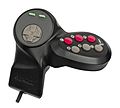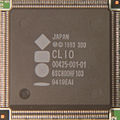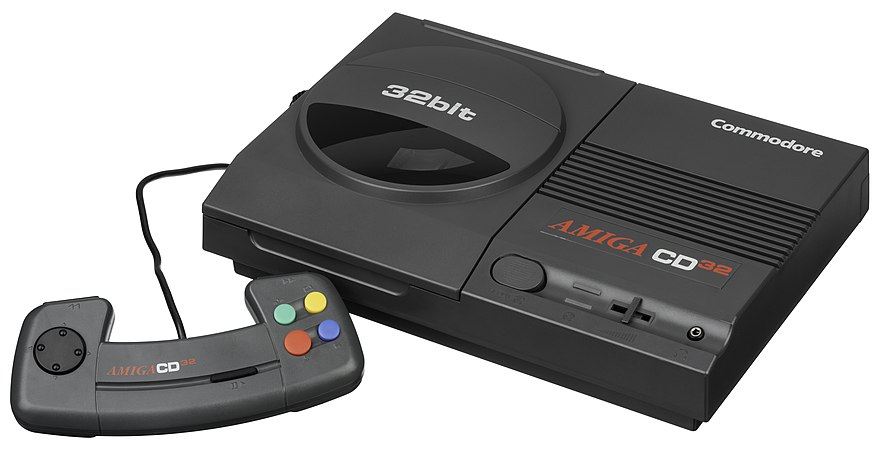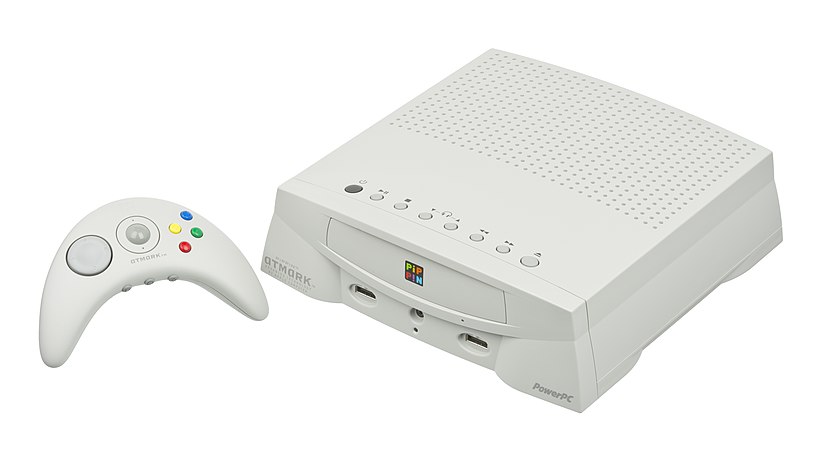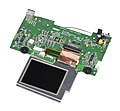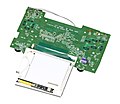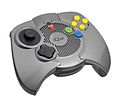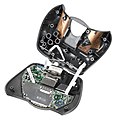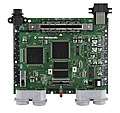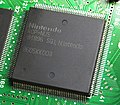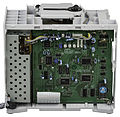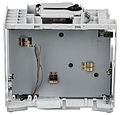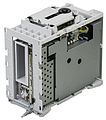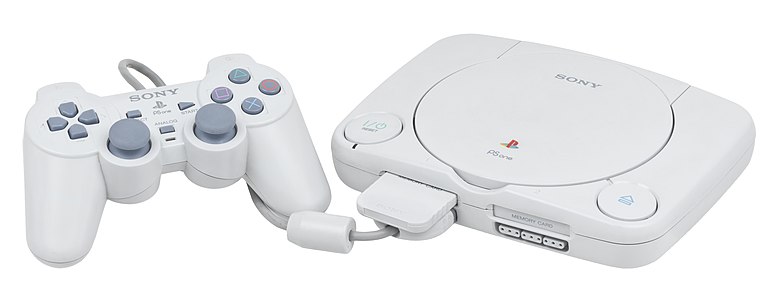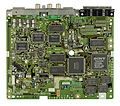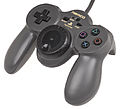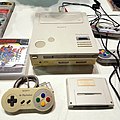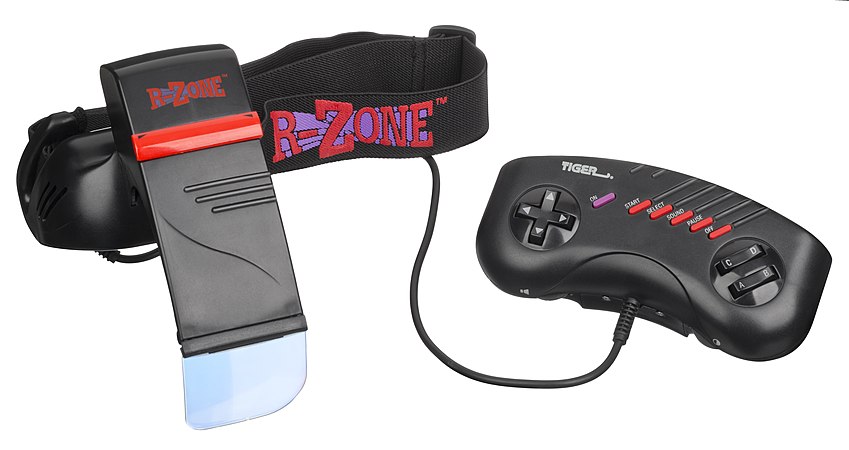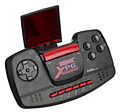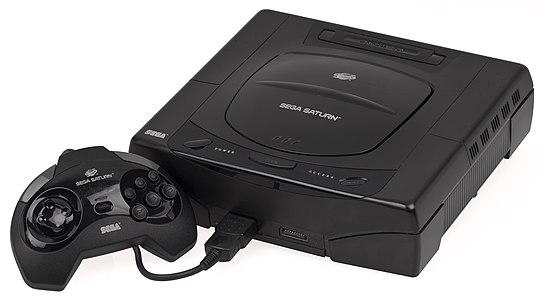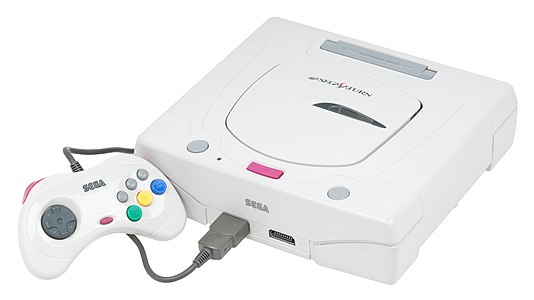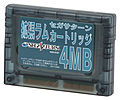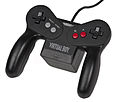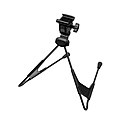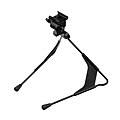History of video games/Print version/Fifth Generation of Video Game Consoles
| This is the print version of History of video games You won't see this message or any elements not part of the book's content when you print or preview this page. |
- Fifth generation of video game consoles
Trends
[edit | edit source]3D Gaming
[edit | edit source]
Polygonal 3D gaming was supported by all major home consoles this generation. However real time 3D graphics on consumer level hardware was still a new concept, and there were many different wildly different approaches to how a 3D system should work in a console. This lead to some consoles being much better at 3D graphics performance and ease of use by developers, and some with performance much less than their at the time impressive specifications would indicate.
Many game series failed to make effective 3D versions of their traditionally 2D games.[1] Crafting a believable 3D environment on the hardware available was difficult. Furthermore, developers not only had to design good controls for a 3D game, they had to explain them to players used to playing 2D games exclusively.[2] All these issues were exasperated by a lack of developers familiar with 3D gaming, even within major development companies.[3] Even developers that were able to competently make 3D games struggled somewhat, with large improvements in 3D game control schemes occurring within the generation as developers figured out ways to improve the player experience.[4][2]
Display technology
[edit | edit source]
Display technology improves rapidly during this time with the final major refinements in CRT displays, and the emergence of new technologies. In 1996 Sonys Trinitron (Aperture grille CRT) patents expire, allowing other manufacturers to produce similar quality television sets[5][6] and improving the gaming experience. In 1998 Phillips introduces the first consumer plasma TV for $15,000.[7] Such TVs would become common in the mid 2000's with improving technology and price drops.
This generation more portable consoles adopted color screens, though monochrome screens were still common.
References
[edit | edit source]- ↑ "10 Classic Gaming Franchises That Didn't Survive The Transition To 3D". TheGamer. 26 June 2019. Retrieved 11 December 2020.
- ↑ a b "Super Mario 64 introduced the camera as a friend and foe in video games" (in en-us). Games. https://games.avclub.com/super-mario-64-introduced-the-camera-as-a-friend-and-fo-1798250469.
- ↑ "shmuplations.com". shmuplations.com. Retrieved 1 January 2021.
- ↑ "Retro Review: Mega Man Legends - YouTube". www.youtube.com. Retrieved 1 January 2021.
- ↑ "History of the CRT TV". BT.com. Retrieved 11 December 2020.
- ↑ "Sony Pulls Plug on Historic Trinitron TV". IEEE Spectrum: Technology, Engineering, and Science News. Retrieved 11 December 2020.
- ↑ Broersma, Matthew. "Flat TV, big price". ZDNet. Retrieved 11 December 2020.
-
Panasonic 3DO FZ1 with controller connected.
-
Goldstar 3DO GDO-101M with controller connected.
-
A Panasonic FZ-10 with controller connected.
History
[edit | edit source]
Development
[edit | edit source]Development of the 3DO started in September 1989, when noted computer and game console designers Dave Needle and Robert J. Mical met with David Morse at a restaurant and noted initial 3DO on a paper napkin at a restaurant.[1][2]
Launch
[edit | edit source]The 3DO was launched in North America on October 4th, 1993[3] at a cost of $699.[4][5] Unlike many also rans of the era, the 3DO was widely publicized, and Time Magazine named the 3DO it's product of the year in 1993.[6]
On March 20th, 1994 the 3DO was launched in Japan.[3]
Legacy
[edit | edit source]Discontinued in 1996, about two million 3DO consoles were sold.[4] Despite it's relatively small market share, the 3DO is known for the talent behind it, namely Trip Hawkins and third party supporting studios such as Naughty Dog, Crystal Dynamics, and Toys for Bob.
The 3DO was intended to be succeeded by the M2, though that system was never released.
Technology
[edit | edit source]
The Panasonic FZ-1 3DO has a 32 bit ARM architecture CPU clocked at 12.5 megahertz.[5] This was quite substantial at launch, though lower end competitors quickly caught up and surpassed this spec within a few years. The system has 2 megabytes of DRAM, and 1 megabyte of Video RAM,[5][7] which was quite also quite a substantial amount of memory for a game console at the time of the 3DO launch.
The 3DO uses a custom Clio chip and a custom Madam chip to accelerate certain tasks.[8][9] The 3DO supported texture mapping and anti-aliasing.[10]
Games
[edit | edit source]
3DO Game Aesthetics
[edit | edit source]Many games for the 3DO were hallmarked by FMV (Full Motion Video) graphics, typically featuring real actors and often featuring early computer generated imagery. FMV was sometimes used nearly exclusively for FMV games. Some other games simply relied on FMV for story cutscenes or environment flair.
Gameplay graphics were often entirely FMV. More interactive games often used simple real time 3D graphics, prerendered 3D graphics, advanced 2D graphics, or some mix of the aforementioned techniques.
1993
[edit | edit source]Crash 'n Burn
[edit | edit source]A launch title and pack in game.
Read more about Crash 'n Burn on Wikipedia.
Escape from Monster Manor
[edit | edit source]An exclusive 3D survival horror first person shooter.
Read more about Escape from Monster Manor on Wikipedia.
Jurassic Park Interactive
[edit | edit source]A 3DO exclusive action game developed as a tie in to the prior year's hit movie Jurassic Park.
Read more about Jurassic Park Interactive on Wikipedia.
The Life Stage: Virtual House
[edit | edit source]A 3DO exclusive construction simulator, and a launch title for the Japanese release of 3DO.
Read more about The Life Stage: Virtual House on Wikipedia.
Twisted: The Game Show
[edit | edit source]A 3DO exclusive party game.
Read more about Twisted: The Game Show on Wikipedia.
Plumbers Don't Wear Ties
[edit | edit source]An adult FMV game.[11]
Read more about Plumbers Don't Wear Ties on Wikipedia.
1994
[edit | edit source]Doctor Hauzer
[edit | edit source]Read more about Doctor Hauzer on Wikipedia.
Advanced Dungeons & Dragons: Slayer
[edit | edit source]Read more about Advanced Dungeons & Dragons: Slayer on Wikipedia.
Station Invasion
[edit | edit source]Read more about Station Invasion on Wikipedia.
Demolition Man
[edit | edit source]Read more about Demolition Man on Wikipedia.
Guardian War
[edit | edit source]Read more about Guardian War on Wikipedia.
Iron Angel of the Apocalypse
[edit | edit source]Read more about Iron Angel of the Apocalypse on Wikipedia.
John Madden Football
[edit | edit source]Read more about John Madden Football on Wikipedia.
PaTaank
[edit | edit source]Read more about PaTaank on Wikipedia.
Kurokishi no Kamen
[edit | edit source]A Japan only, 3DO only, game.
Read more about Kurokishi no Kamen on Wikipedia.
Way of the Warrior
[edit | edit source]Read more about Way of the Warrior on Wikipedia.
1995
[edit | edit source]Blade Force
[edit | edit source]A third person 3D shooter set in a dystopian future crime ridden city.
Read more about Blade Force on Wikipedia.
Foes of Ali
[edit | edit source]Read more about Foes of Ali on Wikipedia.
Guardian War
[edit | edit source]Read more about Guardian War on Wikipedia.
Iron Angel of the Apocalypse: The Return
[edit | edit source]Read more about Iron Angel of the Apocalypse: The Return on Wikipedia.
Pretty Soldier Sailor Moon S
[edit | edit source]A 3DO exclusive 2D fighting game based on the Japanese Sailor Moon media franchise. It was released the same month as Pretty Soldier Sailor Moon, a 2D beat em' up arcade machine with similar graphics.
Read more about Pretty Soldier Sailor Moon S on Wikipedia.
Slam 'N Jam '95
[edit | edit source]A 3DO exclusive basketball game well regarded for its solid two player mode.
Read more about Slam 'N Jam '95 on Wikipedia.
Zhadnost: The People's Party
[edit | edit source]3DO exclusive party game with a dystopian theme and extensive FMV use. The intro cutscene appears to take clear inspiration from the collapse of the Soviet Union, a then recent event.
Read more about Zhadnost: The People's Party on Wikipedia.
1996
[edit | edit source]Doom
[edit | edit source]The 3DO port of Doom was notoriously poor as most development was delegated to a single person with only 10 weeks to perform most of the port.[12][13]
In December 2014 the source code for this port of the game was released.[14][15]
In January 2022 the example of Doom for the 3D0 became a common talking point in the NFT gaming community.[16]
Read more about Doom on Wikipedia.
Gallery
[edit | edit source]Models
[edit | edit source]Controllers
[edit | edit source]Chips
[edit | edit source]External Resources
[edit | edit source]References
[edit | edit source]| Parts of this page are based on materials from: Wikipedia: the free encyclopedia. |
- ↑ "Third Time's a Charm (They Hope)". Wired. https://www.wired.com/1994/01/3do/.
- ↑ "Dave Needle, Original Amiga Engineer and Creator of the Atari Lynx and 3DO, Dies" (in en). Quarter Disorder. 24 February 2016. https://quarterdisorder.com/2016/02/23/dave-needle-original-amiga-engineer-and-creator-of-the-atari-lynx-and-3do-dies/.
- ↑ a b "Panasonic R.E.A.L 3DO Interactive Multiplayer - Game Console - Computing History". www.computinghistory.org.uk. Retrieved 1 August 2021.
- ↑ a b "3DO Interactive Multiplayer (1993 - 1996)". Museum of Obsolete Media. 13 March 2020. Retrieved 28 October 2020.
- ↑ a b c "Panasonic FZ-1 R.E.A.L. 3DO Interactive Multiplayer Video Game Home Console". iFixit. Retrieved 29 October 2020.
- ↑ "THE BEST PRODUCTS OF 1993". Time. 3 November 2005. Retrieved 13 November 2020.
- ↑ "3DO System Info". www.vgmuseum.com. Retrieved 17 November 2020.
- ↑ "Revisiting the Panasonic 3DO FZ-10 32 bit console - is it underrated? Review, Teardown, Games". Retrieved 18 November 2020.
{{cite web}}: Text "MVG" ignored (help) - ↑ Lyon, Tony. "Panasonic FZ-10 3DO Interacvtive Multiplayer". Retro Video Game Systems. Retrieved 18 November 2020.
- ↑ "3DO, Formatting Our Future". www.gamezero.com. Retrieved 21 November 2020.
- ↑ "Abysmal 3DO 'classic' Plumbers Don't Wear Ties is getting a re-release from Limited Run Games" (in en-CA). Destructoid. 18 June 2021. https://www.destructoid.com/plumbers-dont-wear-ties-limited-run-games-rerelease/.
- ↑ Gander, Matt (May 17, 2016). "The unfortunate tale of 3DO DOOM". https://www.gamesasylum.com/2016/05/17/the-unfortunate-tale-of-3do-doom/.
- ↑ Hurley, Leon. "Here's Why the 3DO Port of Doom Sucked" (in en-us). Kotaku. https://kotaku.com/heres-why-the-3do-port-of-doom-sucked-1671138312.
- ↑ "Source code for Doom’s 3DO port has been released online". PCGamesN. https://www.pcgamesn.com/doom/source-code-for-doom-s-3do-port-has-been-released-online.
- ↑ Prescott, Shaun (16 December 2014). "DOOM 3DO source code is now publicly available". PC Gamer. https://www.pcgamer.com/doom-3do-source-code-is-now-publicly-available/.
- ↑ Obedkov, Evgeny (13 January 2022). "Story of 90s Doom 3DO port and what it says about modern-day NFT evangelists’s view of video games". Game World Observer. https://gameworldobserver.com/2022/01/13/story-of-90s-doom-3do-port-and-what-it-says-about-modern-day-nft-evangelists-view-of-video-games.
-
An Amiga CD32 and controller.
History
[edit | edit source]
The Amiga CD32 was preceded by the unsuccessful Commodore CDTV.
The Amiga CD32 was launched in 1993.[1] The CD32 sold decently at launch.[2] The CD32 was met with cautious optimism and skepticism of a future for the system by some reviewers at launch.[3][4]
The system was unable to be launched in the USA due to a legal issue,[5] which further reduced the ability of the CD32 to gain a significant marketshare.
The production of the Amiga CD32 was cut short in April 1994 when Commodore went bankrupt.[1]
Technology
[edit | edit source]Compute
[edit | edit source]The Amiga CD32 is based on the Amiga 1200, and uses a Motorola 68020 CPU and 2 megabytes of RAM.[6] The CPU is clocked at 14.18 megahertz in PAL regions, and 14.32 megahertz in NTSC regions.[7]
Gallery
[edit | edit source]Console
[edit | edit source]Controller
[edit | edit source]Internals
[edit | edit source]Motherboard
[edit | edit source]-
The Spellbound Rev 3 motherboard top, densely packed with components from a number of different manufacturers.
-
The bottom of the motherboard sports long traces.
References
[edit | edit source]- ↑ a b "Commodore Amiga CD32 (1993 - 1994)". Museum of Obsolete Media. 5 April 2020. Retrieved 28 October 2020.
- ↑ "Idiots Guide To Consoles - Amiga CD32Retro Domination". 25 July 2013. Retrieved 21 November 2020.
- ↑ "Amiga CD32 - A Special Preview From Overseas". www.gamezero.com. Retrieved 21 November 2020.
- ↑ "The Amiga CD32 Reviewed". www.amigareport.com. Retrieved 21 November 2020.
- ↑ "Commodore – Montreal Video Game Museum". Retrieved 31 October 2020.
- ↑ Adams, Kara Jane (19 September 2020). "Commodore Amiga CD32". Medium. Retrieved 29 October 2020.
- ↑ Blanchard, Jonn (12 December 2017). "Amiga CD32". Re-enthused: world of retro. Retrieved 30 October 2020.
-
A Pippin Atmark console with wireless Applejack controller.
History
[edit | edit source]
Development
[edit | edit source]The console was primarily developed as a joint effort between Apple and Bandai.[1] Apple was in dire straits and unable to dedicate many resources to producing a console, leading Bandai and other partners to handle most aspects of the console not related to it's core Mac architecture.[1]
A prototype console was referred to as the "Power Player".[2]
Launch
[edit | edit source]The Pippin was announced in late 1994.[3] Marketing for the device was mainly handled by Bandai.[4]
The Japanese and American launches occurred in 1995.[5] The Apple Pippin cost $599.[6][7]
Discontinuation
[edit | edit source]42,000 Apple Pippins were sold.[7] The possibility of Pippin discontinuation had been speculated on since at least February 6th, 1997 as a result of restructuring brought on by the return of Stve Jobs.[8] Such speculation that Jobs would eliminate the product line proved correct, and the Apple Pippin was discontinued later on in 1997.[6][9] In Japan the system was discontinued much later, in 2002.[10]
Technology
[edit | edit source]Compute
[edit | edit source]The Pippin used a 66MHz PowerPC Processor.[11]
Video and System Memory was a combined 6MB.[11]
Storage
[edit | edit source]128 Kilobytes of SRAM resided on the system for saving games and settings[11], with a modified Mac OS 7 operating system residing on each game disk to avoid compatibility and optimization issues.[7][6][9]
The Pippin had a 4x speed CD-ROM drive.[11]
Notable games
[edit | edit source]- Gadget: Invention, Travel, & Adventure
- Gundam Tactics: Mobility Fleet 0079
- Super Marathon
Gallery
[edit | edit source]Bandai Apple Pippin
[edit | edit source]Katz Media Player 2000
[edit | edit source]Applejack Controller
[edit | edit source]IO
[edit | edit source]Internals
[edit | edit source]-
Bandai Apple Pippin Motherboard
-
Pippin Bios
Read more
[edit | edit source]There is a Wikibook on the History of Apple Inc.
References
[edit | edit source]| Parts of this page are based on materials from: Wikipedia: the free encyclopedia. |
- ↑ a b Staff, Ars (24 March 2018). "The Mac gaming console that time forgot" (in en-us). Ars Technica. https://arstechnica.com/gaming/2018/03/the-mac-gaming-console-time-has-forgot/.
- ↑ "La concurrence entre ordinateurs et consoles de jeux s'intensifie" (in fr). Le Monde.fr. 26 November 1995. https://www.lemonde.fr/archives/article/1995/11/26/la-concurrence-entre-ordinateurs-et-consoles-de-jeux-s-intensifie_3888874_1819218.html.
- ↑ "The Cutting Edge: COMPUTING / TECHNOLOGY / INNOVATION : Apple's Pippin Plays Video Games, Plugs Into TV Set". Los Angeles Times. 14 December 1994. https://www.latimes.com/archives/la-xpm-1994-12-14-fi-8786-story.html. Retrieved 24 October 2020.
- ↑ "Apple sold a $599 game console in 1996 — Apple Scoop" (in EN). applescoop.org. https://applescoop.org/story/apple-sold-a-599-game-console-in-1996.
- ↑ Frank, Allegra (8 September 2015). "Before gaming on iOS and Apple TV, there was Pippin" (in en). Polygon. https://www.polygon.com/2015/9/8/9277273/what-is-pippin-apple-tv. Retrieved 24 October 2020.
- ↑ a b c "The Most Unusual Video Game Consoles" (in en). PCMAG. https://www.pcmag.com/news/the-most-unusual-video-game-consoles. Retrieved 24 October 2020.
- ↑ a b c Villas-Boas, Antonio. "Apple made a game console back in 1996, and it was terrible". Business Insider. https://www.businessinsider.com/apple-made-a-games-console-called-pippin-in-1996-2017-6. Retrieved 24 October 2020.
- ↑ "Apple se restructure à nouveau et rappelle ses anciennes gloires" (in fr). Le Monde.fr. 6 February 1997. https://www.lemonde.fr/archives/article/1997/02/06/apple-se-restructure-a-nouveau-et-rappelle-ses-anciennes-gloires_3769697_1819218.html.
- ↑ a b Johnston, Casey (25 August 2011). "For the good of the company? Five Apple products Steve Jobs killed". Ars Technica. Retrieved 24 October 2020.
- ↑ "The Apple game system that failed early in the console wars". SlashGear. 20 January 2022. https://www.slashgear.com/the-apple-game-system-that-failed-early-in-the-console-wars-20708084/.
- ↑ a b c d "PIPPIN TECHNICAL SPECIFICATIONS". web.archive.org. 29 January 1997. Retrieved 24 October 2020.
-
A basic Atari Jaguar and controller.
-
An Atari Jaguar CD and Pro controller.
History
[edit | edit source]
Development
[edit | edit source]The Atari Jaguar was the first major system to be marketed by Atari since the Atari 7800.
The number pad at the bottom of the controller was designed to offer extra control, and also to accept paper overlays per game.[1]
The Atari Jaguar was manufactured in Charlotte, North Carolina and Colorado Springs, Colorado.[2]
Pre-Launch
[edit | edit source]The touted performance of the machine lead some to speculate it would overtake offerings from rival companies Nintendo and Sega.[3]
Launch
[edit | edit source]Do The Math—American Atari Jaguar Slogan, What's in a Name article by Tom Charnock.[4]
The Atari Jaguar launched in 1993 for $250.[5]
Atari did not overly focus on internal software development, instead focusing on their core competency of hardware and leaving software mostly to third parties.[6] This was a critical issue for Atari because they had trouble attracting third-party developers to the Jaguar.[7]
The Do the Math Slogan was part of a marketing effort to get consumers to recognize the Jaguar as a superior 64 bit system.[4] The slogan was not used in British English markets.[4]
Legacy
[edit | edit source]The Atari Jaguar was discontinued in 1996 and rights to the system were released to the public by Hasbro at E3 in 1999.[8][9] The Atari Jaguar sold 250,000 consoles at most,[10] a quite small number for a major console.
While the Jaguar game console had a relatively short production, its case mold was used for around a decade longer in other applications. The machines used to make Atari Jaguar cases were repurposed for making dental equipment cases.[11][12] The Jaguar molds are said to have been reused for the canceled Coleco Chameleon console.[13] The case design itself is a major divisive part of the legacy of the console with some comparing the Jaguar CD equipped systems to a toilet,[14] and others praising the design as possessing a functional layout.[15]
Technology
[edit | edit source]Compute
[edit | edit source]The Jaguar contains five processors, with the primary two 32 bit processors being named Tom and Jerry being clocked at clocked at 26 megahertz.[2][8][16] The Jaguar was capable of 55 Million Instructions Per Second(MIPS).[17] The Jaguar contains two megabytes of RAM.[2]
Development Kits
[edit | edit source]The Jaguar development kit was considered to be well made.[18] The Alpine Development Kit was simply designed as an cartridge with an extended PCB which would be inserted into regular Jaguar consoles.[19]
Notable Games
[edit | edit source]1993
[edit | edit source]- Cybermorph - Flight
1994
[edit | edit source]- Tempest 2000
- Alien vs Predator - FPS
- Kasumi Ninja - Fighting game
1995
[edit | edit source]- Missile Command 3D - Shooter
Canceled
[edit | edit source]Gallery
[edit | edit source]Console
[edit | edit source]Controller
[edit | edit source]Jaguar CD
[edit | edit source]Internals
[edit | edit source]Accessories
[edit | edit source]Places
[edit | edit source]-
Charlotte, North Carolina was one location where the Atari Jaguar was made.
-
Colorado Springs, another location where the Atari Jaguar was made.
External Resources
[edit | edit source]References
[edit | edit source]| Parts of this page are based on materials from: Wikipedia: the free encyclopedia. |
- ↑ "Is This The Worst Controller Ever Made?" (in en-us). Kotaku. https://kotaku.com/is-this-the-worst-controller-ever-made-453103476. Retrieved 25 October 2020.
- ↑ a b c "Jaguar FAQ". atariage.com. Retrieved 15 November 2020.
- ↑ "Le Salon international de la " High Tech " de loisirs La console de jeux vidéo cède le pas à la machine multimédia" (in fr). Le Monde.fr. 30 November 1993. https://www.lemonde.fr/archives/article/1993/11/30/le-salon-international-de-la-high-tech-de-loisirs-la-console-de-jeux-video-cede-le-pas-a-la-machine-multimedia_3967984_1819218.html.
- ↑ a b c Charnock, Tom. "What's in a Name?". http://www.atarijaguar.co.uk/2013/09/whats-in-name.html.
- ↑ "AtariAge - Atari Jaguar History". www.atariage.com. Retrieved 1 December 2020.
- ↑ Burns, Benjamin (19 February 2020). "The story of the Atari Jaguar saviour that never came out". Eurogamer. Retrieved 30 October 2020.
- ↑ Writer, Eric Gwinn, Tribune Staff. "PLAYSTATION, SATURN BATTLE FOR POSITION IN THE MARKETPLACE". chicagotribune.com. Retrieved 1 December 2020.
- ↑ a b "Video game controller:Atari Jaguar Controller - Atari, Inc". Google Arts & Culture. Retrieved 14 November 2020.
- ↑ "Hasbro Releases Jaguar Publishing Rights!!!". www.atarimuseum.com. Retrieved 14 November 2020.
- ↑ "Atari Jaguar (1993-1996)". History of Console Gaming. 14 October 2016. Retrieved 14 November 2020.
- ↑ Orland, Kyle (8 May 2015). ""Retro VGS" console aims to revive the humble video game cartridge [Updated"] (in en-us). Ars Technica. https://arstechnica.com/gaming/2015/05/retro-vgs-console-aims-to-revive-the-humble-video-game-cartridge/. Retrieved 25 October 2020.
- ↑ "The Machines That Literally Made Atari's Last Console" (in en-us). Kotaku. https://kotaku.com/the-machines-that-literally-made-ataris-last-console-5934490. Retrieved 25 October 2020.
- ↑ "Coleco Chameleon console runs into trouble, could lose Coleco branding". Stuff. Retrieved 13 November 2020.
- ↑ "The 10 ugliest pieces of technology ever made". The Telegraph. 12 September 2019. https://www.telegraph.co.uk/technology/2019/09/12/10-ugliest-pieces-technology-ever-made/atari-jaguar/.
- ↑ "The Video Game Critic's Atari Jaguar System Review". videogamecritic.com. Retrieved 1 March 2021.
- ↑ "The Atari Jaguar That Should Have Been". Hackaday. 27 November 2013. https://hackaday.com/2013/11/27/the-atari-jaguar-that-should-have-been/. Retrieved 25 October 2020.
- ↑ "Atari Jaguar - On the Prowl". www.gamezero.com. Retrieved 21 November 2020.
- ↑ "Interview - Hyper Image Productions". www.gamezero.com. Retrieved 21 November 2020.
- ↑ "Alpine Development System". www.jagware.org. Retrieved 8 February 2021.
-
A Casio Loopy with a controller connected. The text "My Seal Computer" and "SV-100" adorn the printer door.
History
[edit | edit source]Development
[edit | edit source]
The Loopy followed the ill-fated PV-1000 as Casio's second major attempt to enter the home video game console market.
While in development, the Loopy was not initially intended to appeal to a specific demographic, with the progression to be a female oriented console being somewhat a matter of happenstance.[1]
Launch
[edit | edit source]The Casio Loopy was released in Japan in October 1995 at a cost of cost 25,000 yen, and was marketed to women.[2] First year production was expected to be 200,000 units,[2] though little is known of actual production or sales numbers.
Legacy
[edit | edit source]Software development ended in November 1996, the final software released in 1997, and console production ended in December 1998.[2]
Though the Loopy was not a big success, it was a much greater success than Casio's previous console, the PV-1000. However the main legacy of the Loopy is more concerned with its reception rather than with its performance on the market. Not only was the Casio Loopy was among the most atypical consoles of the fifth generation, it is one of a select few consoles marketed to appeal to women as a specific demographic. A similar tactic of appealing to non-traditional gamers by forgoing the latest technology, and focusing on a fun and appealing hardware differentiator would later find much greater success with other consoles, such as the Nintendo Wii.[1]
Contentious discussion of the Loopy at the intersection of gaming and feminism emerged during and after the 2010's, with some finding the marketing of the Loopy as quite patronizing,[3] and others hailing the console as a subversion of common narratives of gaming in the 1990's.[1]
Technology
[edit | edit source]
In general, technology in the Casio Loopy was selected to be similar to the Super Famicom, then a market leader.[2] This made the Loopy competitive with fourth generation consoles, but underpowered compared to other fifth generation consoles. As a result, Casio compensated for this by relying heavily on leveraging features of the console not found on competing devices.
The Casio Loopy is powered by a 32 bit RISC SH-1 CPU[2][4][5] clocked at 16MHz. The front of the box proudly advertises 32-bit RISC CPU,[4] suggesting that Casio thought that marketing the Loopy as an advanced 32-bit system was a key marketing point. The Loopy has 512 kilobytes of system RAM and 192 kilobytes of video RAM[6], and supports up to 4 megabytes of game cartridge ROM. Most games used only 2 megabytes of ROM, with some larger titles using 3 megabytes. Games also support battery-backed RAM for save data.
The console outputs graphics in 15-bit color with a maximum palette of 256 colors on screen. The graphics output is handled in part by a Sony CXA1645M RGB encoder chip.[7] The Loopy outputs 4 channel 12 bit PCM audio.[2][5]

The Loopy has a built in color thermal printer, with setting dial to adjust contrast.[8][9] While the printer may seem like a strange choice, the ability to print custom art on stickers (Called "Seals" in the context of the Loopy[10]) proved to be a fun and creative tool for play beyond video games.[1] Output from the printer is 180 DPI resolution and is generally considered to be of good quality,[1] and while a few game consoles of the 1990's would see optional printers released, none would match the quality of the colorful prints of the Loopy.
The Loopy was about one foot long, four inches high, and weighed 3.5 pounds.[1] The console is powered by a 24 volt external power supply.[4]
Optional hardware
[edit | edit source]
The Magical Shop is an add on for the Loopy that allows for screen capture from video streams.[8] The Magical Shop add on cost 14,800 yen,[2] a significant cost at the time.
The Loopy two button mouse used a trackball mechanism.[8]
Games / Software
[edit | edit source]Eleven titles were released for the system.[11]
1995
[edit | edit source]- Dream Change: Kokin-chan's Fashion Party[12]
- Anime Land - Character and scene creation software.[13]
- Magical Shop[14] - Video capture to image manipulator to sticker software.[11]
- PC Collection - Suite containing 10 creative, supernatural, or productivity applications supporting the mouse.[15]
- Lupiton no Wonder Palette - Art application. [16]
- Wanwan Aijou Monogatari - Game featuring a dog[17] named Peach.[11] Worked on by Kenji Terada.[18]
- HARIHARI Seal Paradise - Sticker printing game.[19]
- Nigaoe Artist - Caricature art application[20][21]
1996
[edit | edit source]- Loopy Town no Oheya ga Hoshii! - Life simulation game with room decoration, jobs, and a pet.[22] The game was worked on by Kenji Terada, a writer on the first three Final Fantasy games.[23]
- Little Romance[24] - Dating simulator.[11]
1997
[edit | edit source]Gallery
[edit | edit source]Console
[edit | edit source]Controller
[edit | edit source]Tape Mechanism
[edit | edit source]Internals
[edit | edit source]Variants
[edit | edit source]Preservation
[edit | edit source]As of October 2020 an incomplete skeleton Loopy driver exists for MAME.[6]
References
[edit | edit source]- ↑ a b c d e f Milligan, Caleb Andrew; Bohunicky, Kyle (14 July 2020). "Girly Game History on Paper". ROMchip. 2 (1). Retrieved 22 October 2020.
- ↑ a b c d e f g Packwood, Lewis (15 July 2018). "In the Loopy: the story of Casio's crazy 90s console" (in en). Eurogamer. https://www.eurogamer.net/articles/2018-07-15-in-the-loopy-the-story-of-casios-crazy-90s-console. Retrieved 22 October 2020.
- ↑ "Casio Loopy SV-100". Retro Treasures. 6 October 2016. https://retro-treasures.blogspot.com/2016/10/casio-loopy-sv-100.html.
- ↑ a b c "Casio Loopy 101: 32-bit Japanese Console for Girls". RetroGaming with Racketboy. 19 November 2010. Retrieved 22 October 2020.
- ↑ a b Blanchard, Jonn (29 December 2017). "Casio Loopy". Re-enthused: world of retro. https://re-enthused.com/information/casio-loopy/. Retrieved 22 October 2020.
- ↑ a b "mamedev/mame". GitHub. Retrieved 22 October 2020.
- ↑ "The motherboard for the Casio Loopy". 2 June 2016. Retrieved 22 October 2020.
- ↑ a b c Ashens (Apr 8, 2017). "Casio Loopy Review". Youtube. https://www.youtube.com/watch?v=PNWGVtwTkiM. Retrieved 22 October 2020.
- ↑ "7 Japanese Game Consoles That Never Made it to America" (in en). PCMAG. https://www.pcmag.com/news/7-japanese-game-consoles-that-never-made-it-to-america. Retrieved 22 October 2020.
- ↑ "Loopy by Casio – The Video Game Kraken". Retrieved 20 January 2021.
- ↑ a b c d e OatBob (November 17th, 2007). "Classic Gaming: Girly Console Review: Casio Loopy - My Seal Computer SV-1000 - What about channel 4?". www.rfgeneration.com. https://www.rfgeneration.com/news/classic-gaming/System-Overview-Casio-Loopy-My-Seal-Computer-362.php. Retrieved 22 October 2020.
- ↑ "video game: Casio Loopy Dream Change: Kokin-chan's Fashion Party - Japanese Edition - Casio Computer Co., Ltd". Google Arts & Culture. Retrieved 22 October 2020.
- ↑ "Anime Land (あにめらんど) - Software - Game - Computing History". www.computinghistory.org.uk. Retrieved 22 October 2020.
- ↑ "FEMICOM Magical Shop". www.femicom.org. Retrieved 22 October 2020.
- ↑ "PC Collection (パソコン・コレクション) - Software - Game - Computing History". www.computinghistory.org.uk. Retrieved 22 October 2020.
- ↑ "FEMICOM Lupiton no Wonder Palette". www.femicom.org. Retrieved 22 October 2020.
- ↑ "FEMICOM Wanwan Aijou Monogatari". www.femicom.org. Retrieved 22 October 2020.
- ↑ "Wan Wan Aijō Monogatari (1995) Casio Loopy credits". MobyGames. Retrieved 22 October 2020.
- ↑ "FEMICOM HARIHARI Seal Paradise". www.femicom.org. Retrieved 22 October 2020.
- ↑ "FEMICOM Nigaoe Artist". www.femicom.org. Retrieved 22 October 2020.
- ↑ "Casio Loopy - Nigaoe Artist / 似顔絵アーティスト Intro Movie". Retrieved 22 October 2020.
- ↑ "FEMICOM Loopy Town no Oheya ga Hoshii!". www.femicom.org. Retrieved 22 October 2020.
- ↑ "Kenji Terada, writer for early Final Fantasy games, worked on a little-known Animal Crossing-like game in the 1990s". www.femicom.org. http://www.femicom.org/research/kenji-terada-writer-for-early-final-fantasy-games/. Retrieved 22 October 2020.
- ↑ "FEMICOM Little Romance". www.femicom.org. Retrieved 22 October 2020.
- ↑ "FEMICOM Chakurakun no Omajinai Paradise". www.femicom.org. Retrieved 22 October 2020.
History of video games/Platforms/Design Master Senshi Mangajukuuu
-
FM Towns Marty with controller.
History
[edit | edit source]In February of 1993 Fujistu released the FM Towns Marty in Japan.[1]
The FM Towns Marty cost 98,000 yen at launch, and a 1994 revision cost 66,000 yen.[2]
The Car Marty was briefly released in April 1994, acting as an in car entertainment setup and adding a GPS for car navigation, before it was discontinued in 1995 after failing to sell well.[3][4]
Technology
[edit | edit source]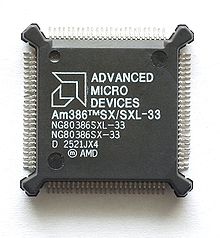
Compute
[edit | edit source]The FM Towns Marty uses a 32 bit AMD 386SX x86 architecture processor clocked at 16 megahertz.[5]
The FM Towns Marty has 2 megabytes of RAM.[6]
Storage
[edit | edit source]The FM Towns Marty had a single speed CD-ROM drive, as well as a 3.5" floppy drive.[5] This was an unusual combination for a console, but it does make sense given the roots of this console in a home computer line.
Notable games
[edit | edit source]The FM Towns Marty is backwards compatible with FM Towns games.[7]
Gallery
[edit | edit source]References
[edit | edit source]- ↑ "FUJITSU GETS CLOSER TO GAMES WITH FM-TOWNS MARTY". Computer Business Review. 17 February 1993. Retrieved 30 October 2020.
- ↑ "Die, 16-bit, Die! - IGN". Retrieved 30 October 2020.
- ↑ Blanchard, Jonn (29 December 2017). "Fujitsu Car Marty". Re-enthused: world of retro. Retrieved 30 October 2020.
- ↑ "Car Marty by Fujitsu Ten – The Video Game Kraken". Retrieved 27 November 2020.
- ↑ a b "Home Page". Video Game Console Library.
- ↑ "FM Towns Marty 1 System Info". www.vgmuseum.com. Retrieved 30 October 2020.
- ↑ "FM Towns Marty - Game Console - Computing History". www.computinghistory.org.uk. Retrieved 30 October 2020.
-
The Tiger Game.com handheld system. The name is pronounced "Game Com", not "Game Dot Com".
History
[edit | edit source]Development
[edit | edit source]The Game.com was preceded by the R-Zone.
Launch
[edit | edit source]The Game.com was launched in the United States in September of 1997 at a cost of about $69.95.[1][2][3] The game console launch was marred by a commercial which backfired.[4]
Legacy
[edit | edit source]The Game.com was discontinued in 2000, and sold under 300,000 consoles.[3][5]
Technology
[edit | edit source]Compute
[edit | edit source]The Game.com uses an 8-bit Sharp SM8521 CPU clocked at 4.9152 megahertz.[3][6]
Hardware
[edit | edit source]The Game.com could use an external modem with a speed of 14.4 kbit/s to connect to the internet.[7]
Notable games
[edit | edit source]- Sonic Jam
- Resident Evil 2
- Duke Nukem 3D
Gallery
[edit | edit source]Console
[edit | edit source]Accessories
[edit | edit source]External Resources
[edit | edit source]- Video Game Kraken - Game.com page.
References
[edit | edit source]| Parts of this page are based on materials from: Wikipedia: the free encyclopedia. |
- ↑ "My Biggest Tech Regret: Tiger Game Com". TechnoBuffalo. 29 November 2014. Retrieved 30 October 2020.
- ↑ "I Miss Simple Video Games That Didn't Try Too Hard". Gizmodo. Retrieved 30 October 2020.
- ↑ a b c "Tiger Game.com 101: A Beginner's Guide". RetroGaming with Racketboy. 21 August 2011. Retrieved 30 October 2020.
- ↑ "Tiger Game.com (1997-2000)". Bad Game Hall of Fame. 13 March 2017. Retrieved 21 April 2021.
- ↑ "The 10 Worst-Selling Handhelds of All Time Feature on GamePro.com". web.archive.org. 13 October 2007. Retrieved 17 November 2020.
- ↑ "Tiger Game.com's SM8521 clock speed is incorrect, instructions have wrong cycle counts too · Issue #7303 · mamedev/mame". GitHub. Retrieved 30 October 2020.
- ↑ "Tiger Game.Com - Game Console - Computing History". www.computinghistory.org.uk. Retrieved 30 October 2020.
-
A Sega Nomad handheld.
History
[edit | edit source]Development
[edit | edit source]The Genesis Nomad was originally the Sega Venus,[1] which kept the naming scheme Sega had been using at the time.
Launch
[edit | edit source]The Genesis Nomad was released in October of 1995 in North America, a development on the previous Japanese Mega Jet which was a portable Mega Drive without a built in screen.[2][3]
Legacy
[edit | edit source]The Genesis Nomad sold about one million units in North America, the only area where it was released.[2] Around the end of 1996 the Genesis Nomad was discontinued.[4]
The Genesis Nomad is typically either classified as a fourth generation console, or a fifth generation console. The classification of fourth generation console is typically used when viewing the system as a Sega Genesis that happens to be portable, and thus should be in the same generation. The classification of fifth generation console is used when observing its capabilities as a handheld in relation to other handheld systems of the era, which more closely match with fifth generation systems. Chronologically the console was either launched very late in the fourth generation, or rather early in the fifth generation. As a result of these factors, this console tends to be categorized differently under different points of view.
Technology
[edit | edit source]The Genesis Nomad has a 3.25" passive matrix LCD which uses composite video internally and tends to ghost.[5]
The Genesis Nomad takes six AA batteries, which can power the Genesis Nomad for about two to three hours.[2][6]
The Nomad audio is powered by a YM3438 chip and has a single speaker for mono audio, though it has a headphone jack.[5]
Game Library
[edit | edit source]The Nomad is essentially a portable Sega Genesis, and plays standard North American region Genesis games.[7] Add on devices like the 32X do not work with the Genesis Nomad.[5]
Gallery
[edit | edit source]Console
[edit | edit source]Internals
[edit | edit source]External Resources
[edit | edit source]References
[edit | edit source]- ↑ "Sega Shows Old Handheld Prototype Publicly For The First Time". Kotaku. Retrieved 1 December 2020.
- ↑ a b c Life, Nintendo (5 November 2014). "Hardware Classics: The Sega Genesis Nomad". Nintendo Life. Retrieved 7 November 2020.
- ↑ "The 10 Worst-Selling Handhelds of All Time Feature on GamePro.com". web.archive.org. 13 October 2007. Retrieved 17 November 2020.
- ↑ Zell-Breier, Sam (16 October 2020). "There was a Sega Genesis handheld and you probably didn't realize it". Looper.com. Retrieved 1 December 2020.
- ↑ a b c Linneman, John (13 May 2018). "DF Retro: Revisiting Sega's Nomad - the original Switch?". Eurogamer. Retrieved 7 November 2020.
- ↑ "USB-powered Sega Nomad gives you near-endless game time". Engadget. Retrieved 7 November 2020.
- ↑ "Someone Fixed The Genesis Nomad's Biggest Problem". Kotaku. Retrieved 30 October 2020.
History
[edit | edit source]Development
[edit | edit source]The Toaster VR was under development from 1992 to 1995 with an expected launch in 1996.[1]
Legacy
[edit | edit source]Hasbro spent millions of dollars developing the Toaster VR before deciding to cancel the project.[2]
The Hasbro Toaster VR is remembered as a potentially industry changing product that was not launched in favor of safer bets in the market.[2]
Technology
[edit | edit source]The Hasbro Toaster VR would have been a 3D oriented system.[3]
An unspecified VR system being made by Hasbro at the time, potentially the Toaster, used three ARC cores for processing.[4][5]
References
[edit | edit source]- ↑ "Hasbro Toaster VR [Cancelled 1992 Virtual Reality Console] - Unseen64". Unseen64: Beta, Cancelled & Unseen Videogames!. 4 October 2018. Retrieved 13 November 2020.
- ↑ a b "Your Engineering Heritage: The Long Road to Consumer Virtual Reality, Part II". IEEE-USA InSight. Retrieved 13 November 2020.
- ↑ "VR Shop - Hasbro Toaster Review - Buy Now, UK". The VR Shop. 17 December 2015.
- ↑ . https://www.eetimes.eu/arc-from-3d-game-chips-to-licensable-risc-processor/.
- ↑ Hamill, Jasper (26 September 2018). "Secrets of lost Nintendo console revealed by British gaming pioneer" (in en). Metro. https://metro.co.uk/2018/09/26/secrets-of-lost-nintendo-console-revealed-by-british-gaming-pioneer-who-led-its-design-7980023/.
-
The Neo Geo Pocket Color handheld console.
History
[edit | edit source]Launch
[edit | edit source]
The monochrome Neo Geo Pocket was released in 1998.[1] Few third parties developed for the Neo Geo Pocket,[2] though the company Dimps worked on many Neo Geo Pocket games.[3] It's most major third party IP to see a release on the system was Sonic, when Sega partnered with SNK to make a portable version of Sonic 2 for the system.[4]
SNK competed hard against the Game Boy line in the United States. This is especially true with the Neo Geo Pocket Color, which offered a console with superior technology compared to the Game Boy Color as wile also undercutting Nintendo, with the system costing only $69.95 at launch.[5] By the year 2000, the Neo Geo Pocket was slightly profitable in the United States, and held a two percent marketshare of handhelds.[6][7] For a new entrant to the market going against an entrenched company, those are quite good numbers given the small timeframe the system was available for sale. Unlike many consoles, internal problems with SNK in Japan rather then the console's market performance would lead to the withdraw of the console in American markets.[8]
Legacy
[edit | edit source]Due to financial difficulties and new ownership of SNK by Aruze, including a rocky stint in the Pachinko business[9], the Neo Geo Pocket Color was discontinued in Canada and the United States on June 13th, 2000.[6][10]
After resuming operations in March, 2001 in October of 2001, SNK was again defunct.[11][12]
The Neo Geo Pocket sold two million consoles.[13] The Neo Geo Pocket Color sold under 200,000 systems.[2]
In 2020 SNK began rereleasing certain Neo Geo Pocket games on the Nintendo Switch.[14]
Technology
[edit | edit source]Neo Geo Pocket
[edit | edit source]The specs of the Neo Geo Pocket are close enough to the Neo Geo Pocket Color that most Neo Geo Pocket Color games will run on it.[15]
Neo Geo Pocket Color
[edit | edit source]Compute
[edit | edit source]The Neo Geo Pocket Color is powered by a primary 16-bit Toshiba TLCS900H processor clocked at 6.144 megahertz and 12 kilobytes of dedicated RAM.[16] A secondary 8-bit Z80 processor used for sound clocked at 3.072 megahertz with four kilobytes of dedicated RAM..[16]
The Neo Geo Pocket Color has 12 kilobytes of RAM, and four kilobytes of sound RAM.[17][6]
Hardware
[edit | edit source]The system has a built in clock.[1]
A wireless link accessory for the Neo Geo Pocket Color was planned.[18]
Notable games
[edit | edit source]1998
[edit | edit source]- Neo Geo Cup '98 Plus Color
- Baseball Stars
- King of Fighters R-1
1999
[edit | edit source]Sonic the Hedgehog Pocket Adventure
[edit | edit source]A portable version of Sonic the Hedgehog 2 released for the Neo Geo Pocket Color.[4] The game was well received at the time and was seen as a major title for the system in a market dominated by the Nintendo GameBoy.[19]
Read more about Sonic the Hedgehog Pocket Adventure on Wikipedia.
2000
[edit | edit source]- Metal Slug 2nd Mission
- Cool Boarders Pocket
- Delta Warp
- Infinity Cure - Visual novel
2001
[edit | edit source]- SNK vs. Capcom: Card Fighter's Clash 2 Expand Edition
Gallery
[edit | edit source]Original
[edit | edit source]Color
[edit | edit source]Accessories
[edit | edit source]Interior
[edit | edit source]Original Interior
[edit | edit source]Color Interior
[edit | edit source]External Resources
[edit | edit source]- Old Computers Museum - Neo Geo Pocket page with specs and history.
- Old Computers Museum - Neo Geo Pocket Color page with specs and history.
References
[edit | edit source]| Parts of this page are based on materials from: Wikipedia: the free encyclopedia. |
- ↑ a b "Neo Geo Pocket Color: The Handheld That Helped Kill a Company". Retrieved 4 November 2020.
- ↑ a b Freeman, Jesse (11 May 2020). "Modernizing A Neo Geo Pocket Color". Medium. Retrieved 4 November 2020.
- ↑ Robinson, Martin (6 September 2020). "The gaming archaeologist and his quest for a Neo Geo holy grail". Eurogamer. Retrieved 4 November 2020.
- ↑ a b "Sonic the Hedgehog Pocket Adventure Gamebits". www.gamebits.net. Retrieved 31 December 2020.
- ↑ Marriott, Michel (20 May 1999). "NEWS WATCH; An Upstart Unveils Rival to the Game Boy (Published 1999)". The New York Times. https://www.nytimes.com/1999/05/20/technology/news-watch-an-upstart-unveils-rival-to-the-game-boy.html.
- ↑ a b c "The History of SNK". GameSpot. Retrieved 4 November 2020.
- ↑ Axton, Gene (8 June 2019). "Retro collector review: Neo Geo Pocket Color". MintCondition.News. Retrieved 20 November 2020.
- ↑ "Interview: Ben Herman, former SNK Playmore USA president SEGA Nerds". Retrieved 20 November 2020.
- ↑ "Ben Herman (SNK) - Interview". Arcade Attack. 25 February 2018. Retrieved 20 November 2020.
- ↑ Kent, Steven. "NeoGeo surrenders -- is Sega next?" (in en). ZDNet. https://www.zdnet.com/article/neogeo-surrenders-is-sega-next/.
- ↑ Bramwell, Tom (31 October 2001). "Rest in peace SNK". Eurogamer. Retrieved 4 November 2020.
- ↑ Bramwell, Tom (14 February 2001). "SNK to Reopen?". Eurogamer. Retrieved 4 November 2020.
- ↑ "The 10 Worst-Selling Handhelds of All Time Feature on GamePro.com". web.archive.org. 13 October 2007. Retrieved 17 November 2020.
- ↑ Byford, Sam (30 April 2020). "Turn your Switch into a Neo Geo Pocket Color with SNK Gals’ Fighters" (in en). The Verge. https://www.theverge.com/2020/4/30/21242396/nintendo-switch-neo-geo-pocket-color-snk-gals-fighters.
- ↑ "SNK Neo-Geo Pocket: A Beginner's Guide". RetroGaming with Racketboy. 4 January 2012.
- ↑ a b "Neo-Geo Pocket Color System Info". www.vgmuseum.com. Retrieved 16 November 2020.
- ↑ "OLD-COMPUTERS.COM : The Museum". www.old-computers.com. Retrieved 20 November 2020.
- ↑ EDT, Newsweek Staff On 9/5/99 at 8:00 PM (5 September 1999). "Who's Got Game?". Newsweek. Retrieved 20 November 2020.
- ↑ Mullen, Micheal. "Sonic returns to handhelds" (in en). ZDNet. https://www.zdnet.com/article/sonic-returns-to-handhelds/.
-
A standard Nintendo 64 with a controller.
-
A Nintendo 64DD.
-
An iQue Player.
History
[edit | edit source]
Development
[edit | edit source]The Nintendo 64 was proceeded by the Super Nintendo Entertainment System and Super Famicom, a family of systems capable of refined 2D graphics, but only extremely limited 3D graphics. Notably the Playstation, among the biggest rivals to the Nintendo 64, also had its roots in the Super Nintendo Entertainment System.
The Nintendo 64 would be the first major home console released by Nintendo with no significant regional differences between American, European, and Japanese releases,[1] The innovative analog stick on the N64 controller was designed by Genyo Takeda.[2] though the China focused iQue player would depart from the design standard of the system.
On February 11th, 1994 Nintendo announced that Project Reality would not use a CD Rom drive, surprising the industry with decision which went against industry trends.[3][4]
A chip shortage in early 1996 delayed the launch of the Nintendo 64 in North America to fall.[5]
Launch
[edit | edit source]"Change the System" and "Get N or Get Out"
The Nintendo 64 was launched in the United States in September of 1996 at a price of $200.[8]
Legacy
[edit | edit source]In North America the Nintendo 64 was discontinued in 2003.[9] The Nintendo 64 sold 32.93 million consoles, and 224.97 million software titles.[10]
The Nintendo 64 was succeeded by the Nintendo GameCube.
A notable lasting legacy of the Nintendo 64 is the gaming journalism outlet IGN, which got its start as an online news outlet focused on the Nintendo 64.[11]
iQue Player
[edit | edit source]In 2003 the iQue player was released as a version of the N64 with enhancements and modifications for the Chinese market.[12]
The iQue Player ceased receiving updates and new games in 2006.[12] Ten years later on December 31st 2016, iQue game download support officially ended.[13] By 2018 the service was fully shuttered.[14] Also in 2018, community members figure out how to unofficially access the iQue software[15]
Technology
[edit | edit source]N64's push to SGI style pixels was technologically premature.—John Carmack, Tweet on February 21st, 2013.[16]
Compute
[edit | edit source]The CPU of the Nintendo 64 is a 64-bit NEC VR4300 (Compatible with the SGI RISC R4300i) MIPS III architecture processor clocked at 93.75 megahertz.[17][18] Despite having a 64 bit CPU, more efficient 32 bit operations were often used by developers.[19]
The Nintendo 64 uses a SGI Reality Co-Processor clocked at 62.5 megahertz, combining the Reality Immersion Processor GPU and Reality Signal Processor Audio system on a single chip.[17][18][20] The GPU alone is capable of 500 MIPS, and can render 150,000 polygons a second.[20]
The Nintendo 64 has four megabytes of RDRAM.[17] The system could be expanded to eight megabytes of RAM.[17]
The Nintendo 64 is capable of 100 megaflops.[21]
Cartridges
[edit | edit source]Official Nintendo 64 Cartridges had a maximum capacity of 64MB.[22] Because of the expense of cartridges, Nintendo 64 games cost much more than games for other systems on CD.[23] To compensate for limited space on cartridges, developers were encouraged to use dynamic music progmatically rather then recorded but static soundtracks.[24]
Cartridges used a CIC lockout chip to stop bootleg games from being produced and to stop piracy.[25][26]
Nintendo 64 DD
[edit | edit source]A version was produced for an American release, but was ultimately never sold.[27]
Special Editions
[edit | edit source]
Special editions and versions of the console.
- Starlight Gaming Station - Kiosk for hospital use.[28]
- McDonalds Kiosk - A kiosk using a Nintendo 64 for use in McDonalds restaurants.[29]
Notable Games
[edit | edit source]Qualities
[edit | edit source]- Fast paced action adventure, platformers, and first person shooter games were quite popular on the system. This is due in part to the specialties of developers who chose the system, and due in part to the unique technological properties of the system favoring such games.
- The Nintendo 64 did not enjoy the same level of support for popular JRPGs as it's predecessor, the SNES. Major JRPG franchises tended to release on competing consoles instead, leaving the Nintendo 64 with more obscure titles.
1996
[edit | edit source]Super Mario 64
[edit | edit source]Of all the games for the Nintendo 64, Super Mario 64 perhaps has the most historic and lasting impact. It's successful translation of Mario from a 2D to a 3D platformer set an example of how a 3D platformer should enhance gameplay, look and control, paving the way for quality games in the genre by it's example. It was the first 3D game experienced by a number of 90's gamers.
Noted developers Cliff Bleszinski and Gabe Newell cite Super Mario 64 as an influence.[30][31]
Long after the discontinuation of the system, the game would find new relevance as a popular game for speedrunners. A number of game specific techniques were developed, such as "Quantum Positioning Units".[32] Another famous speedrunning glitch was discovered on accident, likely as the result of a cosmic ray causing a bit flip.[33][34]
Read more about Super Mario 64 on Wikipedia.
Mario Kart 64
[edit | edit source]An influential game in the Mario Kart series, and the first to take the series into true 3D environments.
Read more about Mario Kart 64 on Wikipedia.
Wave Race 64
[edit | edit source]Jet-ski water racing game.
Read more about Wave Race 64 on Wikipedia.
Pilotwings 64
[edit | edit source]A launch title and casual flight simulator.
Read more about Pilotwings 64 on Wikipedia.
Killer Instinct Gold
[edit | edit source]A port of the arcade fighting game Killer Instinct 2. Known for it's technical excellence with cutting edge graphics for the era.
Read more about Killer Instinct Gold on Wikipedia.
1997
[edit | edit source]GoldenEye 007
[edit | edit source]A standout title, which paved the way for other console first person shooters. It's well remembered for it's local couch co-op mode.
Read more about GoldenEye 007 on Wikipedia.
Star Fox 64
[edit | edit source]An influential on rails shooter. Commonly counted as one of the best entries in the Star Fox series.
Read more about Star Fox 64 on Wikipedia.
Diddy Kong Racing
[edit | edit source]The Diddy Kong Racing soundtrack was shaped to be like Diddy Kong's head, an unusual choice.[35]
Read more about Diddy Kong Racing on Wikipedia.
Doom 64
[edit | edit source]Read more about Doom 64 on Wikipedia.
Yoshi's Story
[edit | edit source]Read more about Yoshi's Story on Wikipedia.
Mischief Makers
[edit | edit source]Shake, Shake!—Marina, Mischief Makers
An eclectic 2D platformer with a distinct style. It was poorly received at launch before later becoming a cult classic.
Read more about Mischief Makers on Wikipedia.
Turok: Dinosaur Hunter
[edit | edit source]Read more about Turok: Dinosaur Hunter on Wikipedia.
1998
[edit | edit source]- Wipeout 64
- Turok 2: Seeds of Evil
- Star Wars: Rogue Squadron
- Space Station Silicon Valley
- Quest 64
- 1080° Snowboarding
The Legend of Zelda: Ocarina of Time
[edit | edit source]A considerable amount of crunch occurred during development.[36]
The game is considered to be among the most important of the generation due to it's pioneering use of 3D game design to make a vast action adventure game with mechanical fluidity paired with excellent audio and graphical fidelity for the era.[37][38] As a result of these factors, this game is often considered among the best ever made.[39][40]
Read more about The Legend of Zelda: Ocarina of Time on Wikipedia.
Mario Party
[edit | edit source]The first entry in the popular Mario Party series.
A minigame control resulted in hand palm injuries by some gamers leading to an investigation by the New York Attorney General, which resulted in protective gloves being shipped to some affected parties.[41]
Read more about Mario Party on Wikipedia.
F-Zero X
[edit | edit source]Fast paced futuristic racer.
Read more about F-Zero X on Wikipedia.
Banjo-Kazooie
[edit | edit source]A 3D platformer and collectathon made by the company Rare.
Read more about Banjo-Kazooie on Wikipedia.
Hey You, Pikachu!
[edit | edit source]A digital pet game about learning to communicate with a Pokemon creature, a Pikachu.[42][43]
One of two games to use the Voice Recognition Unit (VRU).[44] The system could recognize up to 256 words.[45] The game was said to be difficult to control due to either poor voice recognition and or bad microphone quality.[46][47]
Read more about Hey You, Pikachu! on Wikipedia.
1999
[edit | edit source]- Super Smash Bros.
- Turok: Rage Wars
- Superman 64
- Star Wars Episode I: Racer
- Pokémon Stadium
- Ogre Battle 64: Person of Lordly Caliber
- Neon Genesis Evangelion
- Mario Golf
- Jet Force Gemini
- Mario Party 2
- Harvest Moon 64
- Donkey Kong 64
2000
[edit | edit source]- Paper Mario
- Perfect Dark
- The World Is Not Enough
- Turok 3: Shadow of Oblivion
- StarCraft 64
- Star Wars Episode I: Battle for Naboo
- Pokémon Stadium 2
- Indiana Jones and the Infernal Machine
- Sin and Punishment
- Ridge Racer 64
- Mega Man 64
- Mario Party 3
- Mario Tennis
- Kirby 64: The Crystal Shards
- Excitebike 64
- Banjo-Tooie
The Legend of Zelda: Majora's Mask
[edit | edit source]Read more about The Legend of Zelda: Majora's Mask at Wikipedia.
2001
[edit | edit source]Post Market
[edit | edit source]A number of notable titles saw release after the platform was officially discontinued.
40 Winks
[edit | edit source]A game with a rocky development finally shipped an Nintendo 64 version in December of 2018.[48][49]
Read more about 40 Winks on Wikipedia.
Dinosaur Planet
[edit | edit source]A December 1st, 2000 build of Dinosaur Planet for the Nintendo 64 by Rare was unofficially released on the 20th, of February, 2021 as the result of an online leak.[50][51]
Dinosaur Planet had previously been released under a different name following a significant overhaul. Read more about Star Fox Adventures for the GameCube on Wikipedia.
Gallery
[edit | edit source]N64 Console
[edit | edit source]N64 Controllers
[edit | edit source]Accessories
[edit | edit source]64DD
[edit | edit source]Developer Tools
[edit | edit source]iQue Player
[edit | edit source]The Nintendo backed iQue Player released in 2003 exclusively in mainland China, and was an all in one system that played Nintendo 64 games.
Technology
[edit | edit source]Development
[edit | edit source]There is a WikiBook on N64 Programming.
External Resources
[edit | edit source]Archived web materials
[edit | edit source]- Nintendo of America website - 1996
- N64 Website - 1998
- N64 Hardware website - 1998
Other Websites
[edit | edit source]- Video Game Console Library - Nintendo 64 page with technical info.
- Video Game Console Library - Nintendo 64 DD page with technical info.
References
[edit | edit source]| Parts of this page are based on materials from: Wikipedia: the free encyclopedia. |
- ↑ "Lance Barr Interview". nintendojo ~ a site to see. 13 February 2006. https://web.archive.org/web/20060213124455/http://www.nintendojo.com/interviews/view_item.php?1130801472.
- ↑ "Nintendo's hardware visionary is calling it a day" (in en). Engadget. https://www.engadget.com/2017-04-27-nintendos-hardware-visionary-is-calling-it-a-day.html. Retrieved 26 October 2020.
- ↑ Times, Special to The New York (11 February 1994). "COMPANY NEWS; Nintendo's Focus (Published 1994)". The New York Times. https://www.nytimes.com/1994/02/11/business/company-news-nintendo-s-focus.html?searchResultPosition=8.
- ↑ "Retro: This Is Why We Should Probably Be Glad Nintendo Stuck With Carts For The N64". Nintendo Life. 20 February 2017. https://www.nintendolife.com/news/2017/02/retro_this_is_why_we_should_probably_be_glad_nintendo_stuck_with_carts_for_the_n64.
- ↑ "Nintendo Game Is Delayed (Published 1996)". The New York Times. 5 February 1996. https://www.nytimes.com/1996/02/05/business/nintendo-game-is-delayed.html.
- ↑ Tach, Dave (29 September 2014). "Celebrate the N64's 18th anniversary with this 1996 VHS tape" (in en). Polygon. https://www.polygon.com/2014/9/29/6863407/n64-anniversary-change-system-vhs.
- ↑ "New Nintendo Game, Same Distasteful Slogan". Los Angeles Times. 2 April 1998. https://www.latimes.com/archives/la-xpm-1998-apr-02-fi-35155-story.html.
- ↑ "New Nintendo 64 Is a Technical Wonder". Los Angeles Times. 30 September 1996. Retrieved 1 November 2020.
- ↑ "That Was Quick: Nintendo 64 Is 20 Years Old". Fortune. Retrieved 14 November 2020.
- ↑ "IR Information : Sales Data - Dedicated Video Game Sales Units". Nintendo Co., Ltd. Retrieved 14 November 2020.
- ↑ "Welcome to N64.com - IGN" (in en). https://www.ign.com/articles/1996/10/16/welcome-to-n64com.
- ↑ a b "Meet the iQue Player, a Nintendo console that was only available in China" (in en-us). News. https://news.avclub.com/meet-the-ique-player-a-nintendo-console-that-was-only-1798244884.
- ↑ "https://twitter.com/zhugeex/status/793369039766712320" (in en). Twitter. https://twitter.com/zhugeex/status/793369039766712320.
- ↑ "Nintendo Planned to Make a Pokémon MMO for the GameBoy Advance". CBR. 31 July 2020. Retrieved 12 December 2020.
- ↑ "Nintendo's iQue Player Hacked Fifteen Years After Launch". NintendoSoup. 29 April 2018. Retrieved 12 December 2020.
- ↑ "@ID_AA_Carmack". Twitter. https://twitter.com/ID_AA_Carmack/status/304662242627031040?.
- ↑ a b c d "PS1 Strengths and Weaknesses vs N64 and Sega Saturn". RetroGaming with Racketboy. 11 January 2020. Retrieved 29 October 2020.
- ↑ a b "Nintendo 64 Architecture A Practical Analysis". Rodrigo's Stuff. 12 September 2019. Retrieved 29 October 2020.
- ↑ "Advanced Navigation". classes.kvcc.edu. Retrieved 1 November 2020.
- ↑ a b "How N64 Works" (in en). HowStuffWorks. 18 October 2000. https://electronics.howstuffworks.com/n64.htm.
- ↑ "Console Power Comparison Chart". TheGamingSetup. 7 April 2020. Retrieved 4 November 2020.
- ↑ "A Brief and Abbreviated History of Gaming Storage – Techbytes". Retrieved 18 October 2020.
- ↑ "The Game: Sony PlayStation versus Nintendo64" (in en). Forbes. https://www.forbes.com/1997/09/19/feat.html?sh=5073f9c27dd9.
- ↑ "Shigeru Miyamoto Interview - IGN" (in en). https://www.ign.com/articles/1997/02/07/shigeru-miyamoto-interview.
- ↑ Ryan, Mike (15 August 2020). "mikeryan/UltraCIC". Retrieved 9 November 2020.
- ↑ "How Nintendo Stopped Bootleg Games on the Nintendo 64 MVG". Retrieved 9 November 2020.
{{cite web}}:|first1=missing|last1=(help) - ↑ Machkovech, Sam (15 July 2016). "Rare US version of the N64’s disc-drive add-on unearthed near Seattle [Updated"] (in en-us). Ars Technica. https://arstechnica.com/gaming/2016/07/rare-us-version-of-the-n64s-disc-drive-add-on-unearthed-near-seattle/.
- ↑ "Announcing the Starlight Nintendo Switch Gaming Station!". www.starlight.org. Retrieved 29 December 2020.
- ↑ "Nintendo And McDonalds: A Short History" (in en-us). Kotaku. https://kotaku.com/nintendo-and-mcdonalds-a-short-history-5498833.
- ↑ "Nintendo 64: Launching a Legacy - IGN" (in en). https://www.ign.com/articles/2011/09/24/nintendo-64-launching-a-legacy.
- ↑ "Valve's Gabe Newell Thinks Super Mario 64 Is Just Swell". Nintendo Life. 6 March 2014. https://www.nintendolife.com/news/2014/03/valves_gabe_newell_thinks_super_mario_64_is_just_swell.
- ↑ "Famous Super Mario 64 Trick Involving Parallel Universes Finally Becomes Real". Kotaku. https://kotaku.com/the-famous-super-mario-64-trick-involving-parallel-univ-1794215869.
- ↑ Wickens, Katie (13 September 2021). "Rampant space particles might be behind eight-year-old Mario speedrun glitch" (in en). PC Gamer. https://www.pcgamer.com/cosmic-rays-cause-tech-bit-flips-blue-screen-of-death/.
- ↑ "Sorry, you'll never get your Mario to go as fast as this Super Mario 64 Mario" (in en-us). The A.V. Club. https://www.avclub.com/sorry-a-literal-cosmic-ion-ray-boost-to-your-super-mar-1846250037.
- ↑ Elston, Brett. "Game music of the (holi)day: Diddy Kong Racing". gamesradar. Retrieved 11 December 2020.
- ↑ Hagues, Alana (3 May 2022). "Former Nintendo Of America Associate Producer Talks Crunch On Zelda: Ocarina Of Time". Nintendo Life. https://www.nintendolife.com/news/2022/05/former-nintendo-of-america-associate-producer-talks-crunch-on-zelda-ocarina-of-time.
- ↑ Gerstmann, Jeff. "Legend of Zelda: Ocarina of Time, The Review". GameSpot. https://www.gamespot.com/reviews/legend-of-zelda-ocarina-of-time-the-review/1900-2543677/.
- ↑ Schneider, Peer (26 November 1998). "The Legend of Zelda: Ocarina of Time Review" (in en). IGN. https://www.ign.com/articles/1998/11/26/the-legend-of-zelda-ocarina-of-time-review.
- ↑ "Should ‘Ocarina of Time’ Be Called the Greatest Game Ever?". The Hollywood Reporter. 21 November 2018. https://www.hollywoodreporter.com/movies/movie-news/is-legend-zelda-ocarina-time-best-game-ever-1157191/.
- ↑ Luckerson, Victor (23 October 2018). "Why ‘The Legend of Zelda: Ocarina of Time’ Will Always Be the "Best Game Ever"" (in en). The Ringer. https://www.theringer.com/2018/10/23/18012564/legend-of-zelda-ocarina-time-best-game-ever-1998.
- ↑ Becker, David. "Nintendo offers glove to prevent joystick injuries" (in en). CNET. https://www.cnet.com/news/nintendo-offers-glove-to-prevent-joystick-injuries/.
- ↑ "Photographing Magikarp, Voice Chatting With Pikachu, And All Of Our Favorite Pokemon Spin-Offs". GameSpot. https://www.gamespot.com/gallery/photographing-magikarp-voice-chatting-with-pikachu/2900-3412/#2.
- ↑ Peters, Jay (25 February 2021). "Pokémon might be famous for its games, but it also has some great gadgets" (in en). The Verge. https://www.theverge.com/2021/2/25/22298495/pokemon-hardware-gadgets-pikachu-poke-ball-mini-camera-consoles.
- ↑ "The Weird, Weird Games of the Nintendo 64" (in en). www.vice.com. https://www.vice.com/en/article/mv5k7p/acknowledging-the-ultra-ambition-of-the-nintendo-64-645.
- ↑ Moyer, Michael (September 2000). "Popular Science". Bonnier Corporation. Retrieved 3 May 2022.
{{cite journal}}: Cite journal requires|journal=(help) - ↑ LoChiatto, Jonathan (22 December 2021). "Peripherals That Ruined Great Games - Looper". Looper.com. https://www.looper.com/715366/peripherals-that-ruined-great-games/.
- ↑ Simmons, Nathan (17 September 2021). "We Finally Know Why Pikachu Ignored You In Hey You, Pikachu! - SVG". SVG.com. https://www.svg.com/607791/we-finally-know-why-pikachu-ignored-you-in-hey-you-pikachu/.
- ↑ "Update 19: Shipping · 40 Winks - A New Nintendo 64 Game". Kickstarter.
- ↑ "40 Winks Future Uncertain - IGN".
- ↑ Welch, Chris (20 February 2021). "Rare’s unreleased N64 game Dinosaur Planet has leaked" (in en). The Verge. https://www.theverge.com/2021/2/20/22292964/dinosaur-planet-rare-n64-game-leak-star-fox.
- ↑ Yin-Poole, Wesley (20 February 2021). "Rare's unreleased Dinosaur Planet for N64 out in the wild, gameplay emerges" (in en). Eurogamer. https://www.eurogamer.net/articles/2021-02-20-rares-unreleased-dinosaur-planet-for-n64-out-in-the-wild-gameplay-emerges.
-
The NEC PC-FX with controller attached.
History
[edit | edit source]Development
[edit | edit source]NEC had previously attempted to enter the home console market with the TurboGrafx-16 line of consoles.
Launch
[edit | edit source]The PC-FX was launched on the 23rd of December, 1994.[1][2]
The PC-FX GA expansion card was made to allow the PC-FX games to be played on personal computers running the DOS/V operating system and a free ISA expansion slot.[3][4]
The final game for the PC-FX was released in 1998.[1]
Legacy
[edit | edit source]The PC-FX is primarily remembered as a console that excelled in 2D and FMV performance, in an era dominated by demand for 3D gaming. Compared to other consoles of the era, the Japan focused library of games stands out. While many games for the system have aged poorly, they represent design trends that would shortly thereafter fall out of favor, making them an important window into 1990's game design trends. The system is also remembered for it's highly unusual industrial design.
Technology
[edit | edit source]Compute
[edit | edit source]The PC-FX uses a 32-bit RISC NEC V810 CPU clocked at 21.5 megahertz.[5][6] The PC-FX had a performance of 20 million instructions per second (MIPS).[7]
The PC-FX has 3.25 megabytes (26 megabits) of RAM,[6] split between 2 megabytes of system RAM, and 1.25 megabytes of Video RAM.[4]
Co-Processors
[edit | edit source]The PC-FX had a number of subsystems designed to show video streams and other features without taxing the CPU.[1][4]
The most unusual chip, was the Huc6273 3D Accelerator chip, which was found only on the PC-FX GA and not on the PC-FX.[4] Though underutilized, this chip allowed computers with a PC-FX GA to run some real time 3D software that would not be easily possible on a standard PC-FX console.[4]
Hardware
[edit | edit source]The PC-FX CD-ROM drive is a 2x speed drive.[6] The console could be linked with a PC-9800 computer via a special SCSI adapter to allow it to use the CD-ROM drive of the PC-FX,[2] a useful feature in an time where such drives were quite expensive.
The system contained 32 kilobytes of battery backed RAM for long term save game storage and could also accept a memory card in the form of the 128 kilobyte FX-BMP.[4][2] The PC-FX GA emulated this hardware and stored save game data standard floppy disks, hard disks,[4] or other DOS/V accessible storage instead.
The system is noted for being hard to assemble.[8]
Notable games
[edit | edit source]1994
[edit | edit source]Team Innocent: The Point of No Return
[edit | edit source]Team Innocent was a launch title for the PC-FX that used an animated intro screen and sprites on predrawn backgrounds.[9][10]
1995
[edit | edit source]Kishin Dōji Zenki FX: Vajra Fight
[edit | edit source]A beat em up well know for its artful 2D presentation.[11] The game made good use of environmental storytelling in background details as well.[12] The gameplay is well regarded, but the game is notably short, especially for the era in which it was released.[13]
Read more about Kishin Dōji Zenki FX: Vajra Fight on Wikipedia.
Gallery
[edit | edit source]Console
[edit | edit source]PC-FXGA
[edit | edit source]Controllers & Accessories
[edit | edit source]Internals
[edit | edit source]External Resources
[edit | edit source]- Video Game Kraken - PC-FX page about the history of the console.
- Old Computers Museum - PC-FX Page with console history.
- LGR Oddware episode - On the PC-FX GA.
References
[edit | edit source]- ↑ a b c "Feature: What NEC And Hudson Did Next: The Disasterous Story Of The PC-FX". Nintendo Life. 9 May 2015. https://www.nintendolife.com/news/2015/05/feature_what_nec_and_hudson_did_next_the_disasterous_story_of_the_pc-fx. Retrieved 26 October 2020.
- ↑ a b c "OLD-COMPUTERS.COM : The Museum". www.old-computers.com. Retrieved 13 February 2021.
- ↑ "The Strange World of Console-Computer Hybrids" (in en). PCMAG. https://www.pcmag.com/news/the-strange-world-of-console-computer-hybrids. Retrieved 26 October 2020.
- ↑ a b c d e f g "What did we do to deserve the PC-FX? (and the PC-FX GA)". nicole.express. Retrieved 13 February 2021.
- ↑ "PC-FX System Info". www.vgmuseum.com. Retrieved 17 November 2020.
- ↑ a b c "Introducing: The PC-FX". www.gamezero.com. Retrieved 17 November 2020.
- ↑ Murnane, Kevin. "From Pong To Playstation: The 40-Year Evolution Of Gaming Processing Power". Forbes. Retrieved 26 October 2020.
- ↑ "NEC PC-FX - The Successor to the PC-Engine / TurboGrafx - Hardware Overview and History". Retrieved 11 October 2021.
- ↑ "Team Innocent: The Point Of No Return - Software - Game - Computing History". www.computinghistory.org.uk. Retrieved 17 November 2020.
- ↑ "Team Innocent: The Point of No Return for PC-FX (1994)". MobyGames. Retrieved 17 November 2020.
- ↑ "Kishin Douji Zenki FX: Vajra Fight | Retro Gamer". www.retrogamer.net. December 10, 2013. https://www.retrogamer.net/retro_games90/kishin-douji-zenki-fx-vajra-fight/.
- ↑ "Zenki FX: Vajra Fight - The Reason to Own a PC-FX - NEC PC-FX Review" (in en). https://www.youtube.com/watch?v=9RIPcfKd_Fo.
- ↑ "Kishin Douji Zenki FX: Vajura Fight – Hardcore Gaming 101". http://www.hardcoregaming101.net/kishin-douji-zenki-fx-vajura-fight/.
-
Bandai Playdia with wireless inferred controller.
History
[edit | edit source]Development
[edit | edit source]At the June 1994 Tokyo Game Show Bandai announces the BA-X, showcasing a Dragon Ball Z game.[1][2]
Launch
[edit | edit source]The Playdia was released by Bandai in 1994 only in the Japanese market.[3][4][5]
Legacy
[edit | edit source]The Playdia was discontinued in 1996, with remaining units being repurposed for use in arcades.[6][7]
Technology
[edit | edit source]Compute
[edit | edit source]The Playdia is powered by an 8-bit Toshiba TMP87C800F clocked at eight megahertz, and another 8-bit NEC μPD78214GC processor.[3]
The Playdia has 256 kilobytes of RAM, and 512 kilobytes of VRAM.[3]
The Playdia uses a Asahi Kasei AK8000 processor for audio and visual processing.[3]
Hardware
[edit | edit source]The Bandai Playdia has a CD Drive.[3]
The Bandai Playdia uses a wireless controller.[8]
Notable games
[edit | edit source]1994
[edit | edit source]- Dragon Ball Z - Shin Saiyajin Zetsumetsu Keikaku Chikyū Hen
- Bishōjo Senshi Sailor Moon S - Quiz Taiketsu! Sailor Power Kesshū!!
- SD Gundam Daizukan
1995
[edit | edit source]- Bishōjo Senshi Sailor Moon SuperS
1996
[edit | edit source]- Gekisou Sentai Carranger
Gallery
[edit | edit source]Console
[edit | edit source]Internals
[edit | edit source]References
[edit | edit source]| Parts of this page are based on materials from: Wikipedia: the free encyclopedia. |
- ↑ "Consolevariations - Bandai BA-X Playdia Console". Consolevariations. Retrieved 29 November 2020.
- ↑ "EGM (August 1994): "Plan to Eradicate the Saiyans" (Playdia) Coverage". Kanzenshuu. Retrieved 29 November 2020.
- ↑ a b c d e "Video Game Console Library". Video Game Console Library. Retrieved 7 November 2020.
- ↑ "RF Generation: Bandai Playdia (Bandai Playdia)". www.rfgeneration.com. Retrieved 29 November 2020.
- ↑ "Bandai Playdia Console - Boxed from Retrogames". www.retrogames.co.uk. Retrieved 29 November 2020.
- ↑ "Playdia by Bandai – The Video Game Kraken". Retrieved 7 November 2020.
- ↑ "Bandai Playdia - Game Console - Computing History". www.computinghistory.org.uk. Retrieved 29 November 2020.
- ↑ "Bandai Playdia - Ultimate Console Database". ultimateconsoledatabase.com. Retrieved 29 November 2020.
-
Original PlayStation, with upgraded Dual Shock controller.
-
The smaller PSone without an LCD attached.
History
[edit | edit source]
Nintendo Partnership
[edit | edit source]The Play Station was initially a partnership between Nintendo and Sony to develop a disk based add on for the SNES.[1] The partnership fell through when Nintendo made a surprise announcement in 1991 that they were partnering with Phillips for their CD-i system instead, as they did not want to yield control over the SNES CD format to Sony.[2][3]
Development
[edit | edit source]
Despite litigation from Nintendo, Sony continued to develop their game console independently.[2]
Ken Kutaragi was able to keep costs low by leveraging Sony's existing semiconductor and CD-ROM factories.[4] This vertical integration gave Sony a huge cost advantage over competing hardware, which had to buy from external firms instead of an internal supply chain.[5]
The entry of Sony into the console market was initially not taken seriously by the industry.[6] However by building a solid support infrastructure for their console prior to release, Sony was able to sign a number of developers, and even get a few developers to switch their franchises entirely to their platform.[6] The PlayStation was also considered relatively easy to develop for,[7] which was a huge advantage in a market featuring a number of consoles with hard to master architectures.
Launch
[edit | edit source]
Japan
[edit | edit source]The PlayStation launched in Japan on December 3rd, 1994.[8]
North America
[edit | edit source]Sony employee Steve Race announced the cost of the PlayStation in North America at E3 1995, shortly after Sega announced the release of it's Sega Saturn at a cost of $399.[9]
$299—Steve Race, Entire speech at E3 1995.[9]
This short speech launched the room into applause,[10] as the PlayStation was significantly less expensive then competing systems.
Europe
[edit | edit source]The PlayStation was quite popular after launching in France, with a March 4th, 1997 article in Le Monde claiming 600,000 consoles were sold over the prior 18 months.[11]
Revisions
[edit | edit source]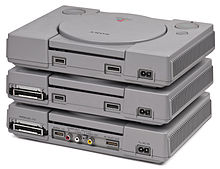
A number of revisions were made during the production of the PlayStation, resulting in the removal of RCA ports and later on the parallel port.[12]
Net Yaroze
[edit | edit source]The Net Yaroze was launched in March of 1997 for $750 to promote independent development for the PlayStation.[13] While not comparable to the full development kit with features like a debugger missing, the system gave Indie developers the opportunity to have demos of their games included in official Demo CDs.[13][14]
Legacy
[edit | edit source]
The original PlayStation was followed by the PlayStation 2.
Manufacturing of the original PlayStation stopped in 2006.[15] The PlayStation was a massively popular console, ultimately selling over 102 million units.[2][16]
The original PlayStation had a popularity long surpassing its launch. Due to its status in the modding community as a cheap and beginner friendly console, unofficial mods for the system continued to be released as recently as 2021.[17][18]
Technology
[edit | edit source]
PS1 was the best design of its generation.—John Carmack, Tweet on February 21st, 2013.[19]
Compute
[edit | edit source]The PlayStation CPU uses a 32 bit RISCI processor derived from an LSI CoreWare CW33300 design, and is clocked at 33.87 megahertz.[20]
The PlayStation has 2 megabytes of RAM and 1 megabyte of VRAM.[21]
The PlayStation did not generate enough heat to need a fan.[22]
Graphics
[edit | edit source]The PlayStation Aesthetic
[edit | edit source]The unique technical attributes of the PlayStation lead to games developed for the system possessing a unique aesthetic. A defining aspect of this are visually sharp polygons which "wobble".[23]
Because of the relatively large storage space available on CD, many games used relatively high resolution textures. However a lack of compute resources meant that these textures were generally not very filtered or smoothed.
It's important to note the context of which the PlayStation would have been used to understand how its graphics would have actually looked to a gamer of the day. Generally game consoles of that period were played on cheap or modest consumer grade CRT televisions, which naturally had a fuzzy sort of quality and distortion to them. These imperfections and flaws thus somewhat worked to obscure console limitations. When playing original PlayStation games on superior displays, it should be noted that the result one sees is different from what would have been generally seen at the time.
Hardware
[edit | edit source]
CD Drive
[edit | edit source]The PlayStation has a 2x speed CD Drive.[24] Though the console is not the first to leverage CD-ROMs, the original PlayStation is perhaps the most iconic console to use CD-ROMs, and is often seen as the archetype of a CD-ROM Console.
Advantages
[edit | edit source]Sony was a major player in the CD-ROM industry, and the PlayStation exists precisely because of this given its origin as an SNES and Super Famicom CD-Add On. However the CD-ROM was important for more than design inertia. The use of CD technology was a major selling point of the system, for both consumers and manufacturers. This is because CD-ROMs were capable of much more storage then consumer grade cartridges of the time, allowing for more expansive games. CDs could be pressed at a lower cost for the manufacturer then the manufacture of cartridges.
Disadvantages
[edit | edit source]While the PlayStation was not the first console to use optical disks, the technology still had a long way to go. The most notable downside was speed, with many games requiring significant loading times. Despite the massive increase of capacity over cartridges, some ambitious developers required even more space than what could be offered by a CD-ROM, requiring some games to be shipped on multiple disks. Additionally, as the 1990s progressed, the proliferation of consumer CD-Burners made piracy for the system extraordinarily easy compared to cartridges.
Accessories
[edit | edit source]Memory Cards
[edit | edit source]Since the PlayStation could not burn save data to CD-ROMS[25] and game saves had become a somewhat standard feature among games, a way for users to save games was needed. This was accomplished with memory cards.
PocketStation
[edit | edit source]In Japan, the Pocketstation was released as a basic handheld console and memory card combo that could sync mobile minigames with PlayStation games.[26]
Games
[edit | edit source]
Qualities
[edit | edit source]- The original PlayStation is seen as an usurper in the JRPG field, with major publishers taking advantage of the system's enhanced storage capabilities, as well as a much lesser degree of publisher restrictions on game content to create new and innovative experiences. Many JRPGs for the original PlayStation are seen as "Killer Apps" for the system.
- Racing and sports games all did well on the original PlayStation.
- Platformers on the original PlayStation have a mixed legacy. While some of the most acclaimed platforms released on the original PlayStation, the system would also see the release of some of the most notorious platformed blunders of the genre.
- Thanks in part due to it's native CD audio capabilities, rhythm and music games did well on the system.
1995
[edit | edit source]Tekken
[edit | edit source]Read more about Tekken on Wikipedia.
Twisted Metal
[edit | edit source]Read more about Twisted Metal on Wikipedia.
Air Combat / Ace Combat
[edit | edit source]Read more about Air Combat on Wikipedia.
1996
[edit | edit source]Crash Bandicoot
[edit | edit source]The first Crash Bandicoot game.
Read more about Crash Bandicoot on Wikipedia.
Tomb Raider
[edit | edit source]Read more about Tomb Raider on Wikipedia.
Tekken 2
[edit | edit source]Read more about Tekken 2 on Wikipedia.
PaRappa the Rapper
[edit | edit source]Read more about PaRappa the Rapper on Wikipedia.
Revelations: Persona
[edit | edit source]The first of a series of games noted for loosely drawing concepts from Jungian psychology.[27]
Read more about Revelations: Persona on Wikipedia.
Resident Evil
[edit | edit source]The first Resident Evil game.
The game included some Live Action cutscenes, and despite using some cutting edge filmmaking techniques for the time, credits for the actors involved were not properly recorded, leaving only the actor's first names in the credits.[28]
The 1998 Resident Evil Director's Cut had music said to be composed by the then famous deaf composer Mamoru Samuragochi, only for it to later be revealed in 2014 that a Samuragochi used a ghostwriter,[29][30] and that Samuragochi was not fully deaf.[31] Samuragochi would later claim he actually had written the music for the Basement section of the game, and backed this up with a recorded VHS performance of him playing it on keyboard in the 1990's.[32] The music of the Directors Cut is often seen as hit or miss, depending on the individual track.[33]
Read more about Resident Evil on Wikipedia.
1997
[edit | edit source]- Gran Turismo - Best selling game on the system
- Final Fantasy VII - First 3D Final Fantasy game
- Tomb Raider II
- Crash Bandicoot 2: Cortex Strikes Back
- Final Fantasy Tactics
- Tomba! - 2.5D platformer adventure
- Moon: Remix RPG Adventure
- Mega Man Legends
Klonoa: Door to Phantomile
[edit | edit source]2.5D mascot platformer Read more about Klonoa: Door to Phantomile on Wikipedia.
Ace Combat 2
[edit | edit source]Read more about Ace Combat 2 on Wikipedia.
1998
[edit | edit source]Xenogears
[edit | edit source]Xenogears was originally supposed to be Final Fantasy 7.[34]
Read more about Xenogears on Wikipedia.
Metal Gear Solid
[edit | edit source]The first 3D game in the Metal Gear series. This game was originally a 3DO title before development shifted to the PlayStation.[35]
The game featured an advanced stealth system, accounting for events such as enemy guards tracking footprints the player left in the snow,[36] using wolf urine to mask the player scent,[35] and other innovative mechanics.
The acclaimed main theme of the game is notably similar to the earlier composition of Winter Road by the famed Russian composer Georgy Sviridov.[37][38]
Read more about Metal Gear Solid on Wikipedia, or read the WikiBook on the general Metal Gear Series.
Spyro the Dragon
[edit | edit source]The first game in the Spyro the Dragon series. This innovative 3D platformer and collectathon allowed more open movement then most other games in the genre at the time.
Read more about Spyro the Dragon on Wikipedia.
1999
[edit | edit source]- Gran Turismo 2
- Final Fantasy VIII
- Tony Hawk's Pro Skater
- Silent Hill
- Chrono Cross
- Tomba! 2: The Evil Swine Return
- Ape Escape
- Pepsiman
- The Misadventures of Tron Bonne
- 40 Winks
- Harvest Moon: Back to Nature
- Crash Team Racing
Persona 2: Innocent Sin
[edit | edit source]Despite being the older release, Innocent Sin was released in North America years after Eternal Punishment due to localization issues arising from including Adolf Hitler as a character.[39]
Read more about Persona 2: Innocent Sin on Wikipedia.
Um Jammer Lammy
[edit | edit source]The sequel to PaRappa the Rapper. The game is noted for it's guitar focused spin on the mechanics of PaRappa the Rapper.[40]
Read more about Um Jammer Lammy on Wikipedia.
Spyro 2: Ripto's Rage
[edit | edit source]The sequel to Spyro was released just a year later, and featured greater movement options, as well as more side quests.
Read more about Spyro 2: Ripto's Rage! on Wikipedia.
Ace Combat 3: Electrosphere
[edit | edit source]Read more about Ace Combat 3: Electrosphere on Wikipedia.
2000
[edit | edit source]- Final Fantasy IX
- Spyro: Year of the Dragon
- Crash Bash
- Dragon Quest VII
- Persona 2: Eternal Punishment
- Mega Man Legends 2
Vagrant Story
[edit | edit source]Vagrant Story is known for its system defying artwork, which used subtle application of pixel art and 3D tricks to create an incredibly detailed environment, especially given the limitations of the hardware.[41][42]
Read more about Vagrant Story on Wikipedia.
2001
[edit | edit source]Tear Ring Saga
[edit | edit source]A tactical role playing game developed by Shouzou Kaga, the creator of the Fire Emblem series.[43] Nintendo would later take legal action over the close similarities between this game and Fire Emblem.[44]
Read more about Tear Ring Saga on Wikipedia.
Gallery
[edit | edit source]PlayStation
[edit | edit source]PSone
[edit | edit source]PSone Internals
[edit | edit source]Controllers
[edit | edit source]Accessories
[edit | edit source]Development
[edit | edit source]Nintendo Play Station
[edit | edit source]The prototype Nintendo Play Station.
Marketing
[edit | edit source]-
PlayStation Logo
-
PlayStation console logotype.
-
PSOne logotype.
References
[edit | edit source]| Parts of this page are based on materials from: Wikipedia: the free encyclopedia. |
- ↑ Walton, Mark (9 November 2015). "The fabled SNES-PlayStation prototype has been turned on and disassembled" (in en-us). Ars Technica. https://arstechnica.com/gaming/2015/11/the-fabled-snes-playstation-prototype-has-been-turned-on-and-disassembled/. Retrieved 18 October 2020.
- ↑ a b c Walton, Mark (3 July 2015). "Fabled CD-playing, SNES-compatible "Play Station" prototype found in a box". Ars Technica. Retrieved 18 October 2020.
- ↑ Shapiro, Eben (3 June 1991). "Nintendo-Philips Deal Is a Slap at Sony (Published 1991)". The New York Times. Retrieved 17 November 2020.
- ↑ "Hideki Sato Discussing the Sega Saturn". Mega Drive Shock. 16 June 2020. Retrieved 27 October 2020.
- ↑ "Hideki Sato talks about creating SEGA Saturn hardware and Sony asking SEGA to go third party". Hideki Sato talks about creating SEGA Saturn hardware and Sony asking SEGA to go third party. Retrieved 2 January 2021.
- ↑ a b "PlayStation: How Sony came to dominate the gaming industry". Digital Innovation and Transformation. Retrieved 18 October 2020.
- ↑ "Interview - Seth Mendelsohn". www.gamezero.com. Retrieved 21 November 2020.
- ↑ "Decade of dominance for PlayStation". 3 December 2004. http://news.bbc.co.uk/2/hi/technology/4054797.stm. Retrieved 28 October 2020.
- ↑ a b "It's Been 25 Years Since Sega Shocked the Gaming World: Here's What Happened" (in en). PCMAG. https://www.pcmag.com/news/its-been-25-years-since-sega-shocked-the-gaming-world-heres-what-happened. Retrieved 26 October 2020.
- ↑ "PlayStation 25th Anniversary: How Sony created the console that redefined the game industry". Edge Magazine. Retrieved 26 October 2020.
- ↑ "Le public des consoles de jeux prend de l'âge" (in fr). Le Monde.fr. 4 March 1997. https://www.lemonde.fr/archives/article/1997/03/04/le-public-des-consoles-de-jeux-prend-de-l-age_3765876_1819218.html.
- ↑ Byford, Sam (11 July 2019). "A brief history of cutdown game consoles" (in en). The Verge. https://www.theverge.com/circuitbreaker/2019/7/11/20690011/nintendo-switch-lite-game-console-redesign-xbox-playstation. Retrieved 19 October 2020.
- ↑ a b "15 Years Later: How Sony's Net Yaroze Kickstarted Indie Console Development". Retrieved 25 November 2020.
- ↑ "Doing It Together: Remembering PlayStation's Net Yaroze Console". www.vice.com. Retrieved 25 November 2020.
- ↑ "Sony stops making original PS". GameSpot. https://www.gamespot.com/articles/sony-stops-making-original-ps/1100-6146549/. Retrieved 28 October 2020.
- ↑ "The bestselling consoles of all time". www.digitaltrends.com. Retrieved 14 November 2020.
- ↑ "VGA Without The Hassle, From Your PlayStation One". Hackaday. 12 February 2021. https://hackaday.com/2021/02/12/vga-without-the-hassle-from-your-playstation-one/.
- ↑ "Burning Your Own PS1 Modchip Is Easy". Hackaday. 1 November 2020. https://hackaday.com/2020/11/01/burning-your-own-ps1-modchip-is-easy/.
- ↑ "@ID_AA_Carmack". Twitter. https://twitter.com/ID_AA_Carmack/status/304662242627031040?.
- ↑ "PlayStation Architecture A Practical Analysis". Rodrigo's Stuff. 8 August 2019. Retrieved 29 October 2020.
- ↑ "PS1 Strengths and Weaknesses vs N64 and Sega Saturn". RetroGaming with Racketboy. 11 January 2020. Retrieved 29 October 2020.
- ↑ Gartenberg, Chaim (3 December 2019). "Remember how simple consoles used to be with this original PlayStation teardown" (in en). The Verge. https://www.theverge.com/circuitbreaker/2019/12/3/20993374/playstation-sony-ifixit-teardown-simple-hardware-internal-components-cd-drive. Retrieved 20 October 2020.
- ↑ "PlayStation 1 Graphics Wobble". RetroRGB. 26 March 2020. https://www.retrorgb.com/playstation-1-graphics-wobble.html.
- ↑ "Sony PlayStation Teardown". iFixit. 3 December 2019. Retrieved 29 October 2020.
- ↑ Note: It is sometimes possible to burn data to finished CD-ROMs with unused space, but this is unsuitable for consumer applications, and the original PlayStation lacked a CD burner, making this infeasible.
- ↑ Byford, Sam (4 December 2019). "The portable PlayStations were Sony at its most ambitious" (in en). The Verge. https://www.theverge.com/2019/12/4/20991654/psp-vita-portable-playstation-console-sony-25-anniversary. Retrieved 20 October 2020.
- ↑ Tisdale, Alex. "'Persona' Bends But Doesn't Totally Break Jungian Psychology" (in en). Inverse. https://www.inverse.com/article/22672-persona-carl-jung-psychology-matthew-fike-interview.
- ↑ "23-Year-Old Resident Evil Mystery Solved". Game Rant. 26 December 2019. https://gamerant.com/resident-evil-actor-rebecca/.
- ↑ "Noted deaf composer admits his music was ghostwritten". The Japan Times. 5 February 2014. https://www.japantimes.co.jp/news/2014/02/05/national/noted-deaf-composer-admits-someone-else-writes-his-music/.
- ↑ Yin-Poole, Wesley (5 February 2014). "Resident Evil and Onimusha composer exposed as a fraud" (in en). Eurogamer. https://www.eurogamer.net/articles/2014-02-05-resident-evil-and-onimusha-composer-exposed-as-a-fraud.
- ↑ "Japan's Fraudulent Composer Returns Years Later With New Music" (in en-us). Kotaku. https://kotaku.com/japans-fraudulent-composer-returns-years-later-with-new-1846728880.
- ↑ "Disgraced Composer Proves He Wrote Basement Theme" (in en). Dead Entertainment. https://deadentertainment.com/2018/04/27/disgraced-composer-proves-he-wrote-basement-theme/.
- ↑ Balmont, James. ""Clowns farting": The wild story behind Resident Evil's worst soundtrack" (in en). Inverse. https://www.inverse.com/gaming/resident-evil-25-composer-mamoru-samuragochi-impostor.
- ↑ "Anime and Games That Wouldn't Exist Without Neon Genesis Evangelion". IGN Southeast Asia. 5 October 2020. Retrieved 17 November 2020.
- ↑ a b "How Metal Gear Solid empowered the stealth genre". Den of Geek. 7 February 2013. https://www.denofgeek.com/games/how-metal-gear-solid-empowered-the-stealth-genre/.
- ↑ Kuchera, Ben (11 February 2021). "The 10 essential examples of snow and ice in video games" (in en). Polygon. https://www.polygon.com/essentials/2021/2/11/22268302/snow-ice-levels-games-best-worst-sonic-tomb-raider-star-wars-hoth-metal-gear.
- ↑ Alexander, Leigh. "Report: Konami Didn't Use Metal Gear Solid Theme In MGS4 Due To Plagiarism Accusations" (in en). www.gamasutra.com. https://www.gamasutra.com/php-bin/news_index.php?story=21513.
- ↑ Square, Push (9 November 2015). "Ever Wonder Why the Classic Metal Gear Solid Theme Isn't in the Phantom Pain?". Push Square. https://www.pushsquare.com/news/2015/11/ever_wonder_why_the_classic_metal_gear_solid_theme_isnt_in_the_phantom_pain.
- ↑ Hilliard, Kyle. "Learn How Hitler's Cameo In Persona 2: Innocent Sin Complicated Localization For North America" (in en). Game Informer. https://www.gameinformer.com/b/news/archive/2015/08/23/learn-how-hitler-39-s-cameo-in-persona-2-innocent-sin-complicated-localization-for-north-america.aspx.
- ↑ "10 Rare PS1 Classics On The Older PlayStation Store You Need To Buy Before It Closes". TheGamer. 3 April 2021. https://www.thegamer.com/best-ps1-classics-playstation-store/.
- ↑ Lee, Richmond (6 December 2019). "The Forgotten Pixel Art Masterpieces of the PlayStation 1 Era" (in en). Medium. https://onezero.medium.com/the-forgotten-pixel-art-masterpieces-of-the-playstation-1-era-8b453dfe00bf.
- ↑ Yin-Poole, Wesley (10 February 2020). "Vagrant Story, one of the greatest JRPGs ever, turns 20" (in en). Eurogamer. https://www.eurogamer.net/articles/2020-02-10-vagrant-story-one-of-the-greatest-jrpgs-ever-turns-20.
- ↑ "The 10 Best Fan Translation Rom Hacks Of Games Never Released In North America". TheGamer. 1 September 2020. https://www.thegamer.com/best-fan-translation-rom-hacks-games-never-released-north-america/.
- ↑ "Nintendo Sues Over Emblem Copyright - IGN" (in en). https://www.ign.com/articles/2001/07/25/nintendo-sues-over-emblem-copyright.
-
Pokémon Pikachu
-
Pokémon Pikachu Color.
History
[edit | edit source]Pokemon Pikachu was released in Japan on Friday, March 27th, 1998 for 2,500 yen.[1] The system was later released in North America on November 2nd, 1998 for $19.95.[2] This dedicated console used a pedometer to measure player activity and create an fusion of exercising and a digital pet gaming experience on the go.[2] The system also featured a slot machine gambling mechanic.[3][4]
The Pokémon Pikachu 2 GS was released in Japan on Sunday, November 21st, 1999 for 3,000 yen,[5] and in North America and Europe the following year.[3]
The Pokémon Mini was a cartridge based followup console released in 2001. Some consider the later Poke Walker accessory for the Nintendo DS to be part of the legacy of this device, as it shares a similar concept.[6]
Technology
[edit | edit source]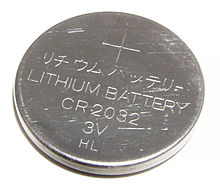
The console had built in clock, as well as a pedometer for measuring player activity.[2] The system can be cliped onto a belt,[7] making it an early example of wearable computing and a wearable console.
The original Pokemon Pikachu used a black and white screen.[8]
The Pokemon Pikachu 2 GS featured a color screen and inferred port, which could send data to other Pokemon Pikachu 2 GS handhelds, as well as to GameBoy Color consoles.[9][3]
The system is powered by a single CR2032 disposable lithium coin cell battery.[10]
External Resources
[edit | edit source]- Google Arts and Culture - Contains a picture of a unit in packaging.
References
[edit | edit source]- ↑ "Take a tech-tech walk with Pikachu!". www.nintendo.co.jp. Retrieved 27 February 2021.
- ↑ a b c "Nintendo: Press Release". web.archive.org. 18 February 1999. Retrieved 23 December 2020.
- ↑ a b c Peters, Jay (25 February 2021). "Pokémon might be famous for its games, but it also has some great gadgets" (in en). The Verge. https://www.theverge.com/2021/2/25/22298495/pokemon-hardware-gadgets-pikachu-poke-ball-mini-camera-consoles.
- ↑ "Pocket Pikachu". www.nintendo.co.jp. Retrieved 27 February 2021.
- ↑ "Pokemon Pikachu Color With Gold and Silver!". www.nintendo.co.jp.
- ↑ "Pokemon Gold/Silver remakes let you train Pokemon by walking". web.archive.org. 11 June 2009. https://web.archive.org/web/20090611155834/http://www.joystiq.com/2009/06/08/pokemon-gold-silver-remakes-let-you-train-pokemon-by-walking.
- ↑ "CNN - Interactive entertainment: Bigger than ever - May 29, 1998". www.cnn.com. http://www.cnn.com/TECH/computing/9805/29/e.three/index.html.
- ↑ "Pocket Pikachu - Game Console - Computing History". www.computinghistory.org.uk. Retrieved 23 December 2020.
- ↑ "Nintendo - Customer Service Other Systems - Pokémon Pikachu 2 GS". web.archive.org. 13 June 2016. Retrieved 23 December 2020.
- ↑ "Poke Pika". www.nintendo.co.jp. Retrieved 23 December 2020.
-
R-Zone headset with controller attached.
History
[edit | edit source]The R-Zone HeadGear was launched in 1995 at a cost of $30.[1][2][3] This system was not successful for a number of reasons, notably including giving players headaches.[4]
The R-Zone SuperScreen was launched in 1996.[3] The R-Zone X.P.G. and R-Zone DataZone were released in 1997.[3]
After selling poorly production of the R-Zone ceased in 1997.[1]
The R-Zone was succeeded by the Game.com.
Technology
[edit | edit source]The R-Zone uses 4-bit Sharp SM5xx series processors.[5]
Notable games
[edit | edit source]- Batman & Robin
Gallery
[edit | edit source]General Technology
[edit | edit source]-
R-Zone cartridges also included the console screen.
-
A Sharp SM510 processor die with top metal removed, similar to the one used in the R-Zone.
-
A Sharp SM510 processor die with top metal present, similar to the one used in the R-Zone.
Headset
[edit | edit source]-
The R-Zone headset.
-
The R-Zone controller.
XGP
[edit | edit source]SuperScreen
[edit | edit source]-
The SuperScreen in closed position
-
The SuperScreen in open position.
External Resources
[edit | edit source]- Video Game Kraken - R-Zone page with additional history and gallery of game cartridges.
References
[edit | edit source]| Parts of this page are based on materials from: Wikipedia: the free encyclopedia. |
- ↑ a b "Tiger Electronics R-Zone 101: A Beginners Guide". RetroGaming with Racketboy. 6 August 2010. Retrieved 26 October 2020.
- ↑ "Tech Time Warp of the Week: Remembering the Worst 'Virtual Reality' Game System Ever" (in en-us). Wired. https://www.wired.com/2015/03/tech-time-warp-week-remembering-worst-virtual-reality-game-system-ever/. Retrieved 26 October 2020.
- ↑ a b c "mamedev/mame". GitHub. Retrieved 16 November 2020.
- ↑ "Tiger R-Zone von Tiger Electronics [BINARIUM]". binarium.de. Retrieved 20 November 2020.
- ↑ "mamedev/mame". GitHub. Retrieved 16 November 2020.
-
Sega Saturn Model 1
-
Sega Saturn Model 2
History
[edit | edit source]Development
[edit | edit source]Sega approached both Sony and Silicon Graphics about collaborating on console hardware, but these deals fell through.[1] Both companies would market consoles that would prove to be significant competitors to the Saturn. Sony would launch the original Playstation and Silicon Graphics became a key technology partner with Nintendo during the development of the Nintendo 64.
The Sega Saturn was initially focused on 2D games, but fearing competition from Sony's Playstation, Sega engineer Hideki Sato decided to add another CPU to give the Saturn extra power this without consulting the company's main experts in 3D Graphics, who were busy in the Arcade division.[2][3] This lead to a strange and unique technical architecture for the Saturn, which somewhat increased it's capabilities at the great expenses of additional production costs and development complexity.
Launch
[edit | edit source]
The Sega Saturn was launched in Japan in November of 1994 at a cost of 44,800 yen.[4]
The Sega Saturn was launched in the USA four months earlier then initially planned when a surprise E3 1995 announcement was made that the Saturn would be released that weekend at a price of $399, which caused Sega to take a $100 loss on each Saturn sold.[5] The surprise launch damaged relations with 3rd party developers and retailers.[6]
Sega had a hard time attracting 3rd party developers in part because the Saturn very difficult to develop for on its own, and this was made worse by the Saturn initially lacking a compiler - requiring programmers to use platform specific assembly for Saturn games.[3]
In December 1995 the Hi-Saturn was released in Japan at a cost of 150,000 yen.[7][8] The Hi-Saturn is an automotive version of the Saturn that was a GPS navigation system and entertainment system.[8][7]
Legacy
[edit | edit source]The Sega Saturn was discontinued in 1998.[9] The system sold less than 10 million units, but has a cult following.[10] The Saturn was followed by the Dreamcast.
Following the failure of the Saturn, Ken Kutaragi of Sony would boast to Saturn designer Hideki Sato of the vertical integration advantage Sony had over Sega, and urged them to become a software focused developer, which Sega eventually did following the inability of the Dreamcast to gain marketshare.[2]
By 2020 the Sega Saturn was known as a difficult console to collect for.[11]
Technology
[edit | edit source]Saturn was nuts—John Carmack, Tweet on February 21st, 2013.[12]
Compute
[edit | edit source]The Sega Saturn has two Hitachi 32-bit SH-2 processors clocked at 28.63 megahertz with 4 kilobytes of cache memory.[13][14]
The Sega Saturn has 2MB of RAM, split into one megabyte of SDRAM, and one megabyte of slower DRAM.[14] The Saturn also has 1.5 megabytes of VRAM.[15]
The Saturn uses two custom GPUs, the VDP1 and the VDP2.[14]
Hardware
[edit | edit source]Audio was handled by the Saturn Custom Sound Processor, the Yamaha YMF292.[16]
Development Hardware
[edit | edit source]A special development model, Sega Saturn Address Checker, was used by developers to verify memory usage compliance.[17] Early revisions of this hardware is notable for it's length, at approximately 3 feet (0.91 m) long.[18]
Notable Games
[edit | edit source]
1995
[edit | edit source]Panzer Dragoon
[edit | edit source]A cult classic rail shooter.
Read more about Panzer Dragoon on Wikipedia.
1996
[edit | edit source]1997
[edit | edit source]Shining Force III
[edit | edit source]Read more about Shining Force III on Wikipedia.
Last Bronx
[edit | edit source]Read more about Last Bronx on Wikipedia.
Devil Summoner: Soul Hackers
[edit | edit source]An entry in the Shin Megami Tensei series.
Read more about Devil Summoner: Soul Hackers on Wikipedia.
Sonic R
[edit | edit source]A racing game in the Sonic series, and the poster Sonic game for the Sega Saturn. Well known for the song "Super Sonic Racing".
Read more about Sonic R on Wikipedia.
Shinrei Jusatsushi Tarōmaru
[edit | edit source]A sidescroller action game noted for its extremely limited production run.
Read more about Shinrei Jusatsushi Tarōmaru on Wikipedia.
Cotton 2: Magical Night Dreams
[edit | edit source]A port of the arcade side scrolling shooter game.
Read more about Cotton 2: Magical Night Dreams on Wikipedia.
Bulk Slash
[edit | edit source]Open 3D environment mech game.
Read more about Bulk Slash on Wikipedia.
1998
[edit | edit source]The House of the Dead
[edit | edit source]Read more about The House of the Dead on Wikipedia.
Radiant Silvergun
[edit | edit source]Read more about Radiant Silvergun on Wikipedia.
Gallery
[edit | edit source]Consoles
[edit | edit source]Controllers & Accessories
[edit | edit source]Internals
[edit | edit source]Marketing
[edit | edit source]-
Sega Saturn USA version logotype.
-
Sega Saturn Japanese version logotype.
References
[edit | edit source]| Parts of this page are based on materials from: Wikipedia: the free encyclopedia. |
- ↑ Shea, Brian. "How A Series Of Bad Decisions Led To The Sega Saturn Failure" (in en). Game Informer. https://www.gameinformer.com/b/features/archive/2017/07/03/gi-classic-the-saturn-spiral.aspx. Retrieved 27 October 2020.
- ↑ a b "Hideki Sato talks about creating SEGA Saturn hardware and Sony asking SEGA to go third party". Hideki Sato talks about creating SEGA Saturn hardware and Sony asking SEGA to go third party. http://segabits.com/blog/2018/06/29/hideki-sato-talks-about-creating-sega-saturn-hardware-and-sony-asking-sega-to-go-third-party/.
- ↑ a b "Hideki Sato Discussing the Sega Saturn". Mega Drive Shock. 16 June 2020. Retrieved 27 October 2020.
- ↑ "HISTORY SEGA 60th Anniversary". SEGA 60th Anniversary site. Retrieved 18 November 2020.
- ↑ "It's Been 25 Years Since Sega Shocked the Gaming World: Here's What Happened" (in en). PCMAG. https://www.pcmag.com/news/its-been-25-years-since-sega-shocked-the-gaming-world-heres-what-happened. Retrieved 26 October 2020.
- ↑ Reisinger, Don. "Why the Saturn was the worst major console of all time". CNET. Retrieved 29 October 2020.
- ↑ a b "Sega / Hitachi HiSaturn Navi". nfggames.com. Retrieved 29 October 2020.
- ↑ a b Beyman, Alex (26 January 2019). "Remember That Time the Sega Saturn was an In-Car GPS Navigation System? …No?". Medium. Retrieved 29 October 2020.
- ↑ "Sega Saturn - Game Console - Computing History". www.computinghistory.org.uk. Retrieved 27 October 2020.
- ↑ Parish, Jeremy (18 November 2014). "The Lost Child of a House Divided: A Sega Saturn Retrospective" (in en). USgamer. https://www.usgamer.net/articles/the-lost-child-of-a-house-divided-a-sega-saturn-retrospective. Retrieved 27 October 2020.
- ↑ "Collecting Sega Saturn Games Is A Total Nightmare" (in en-us). Kotaku. https://kotaku.com/collecting-sega-saturn-games-is-a-total-nightmare-1844421642.
- ↑ "@ID_AA_Carmack". Twitter. https://twitter.com/ID_AA_Carmack/status/304662242627031040?.
- ↑ "Sega Saturn - game console Specs". CNET. Retrieved 29 October 2020.
- ↑ a b c "Sega Saturn Architecture A Practical Analysis". Rodrigo's Stuff. 3 August 2019. Retrieved 29 October 2020.
- ↑ "PS1 Strengths and Weaknesses vs N64 and Sega Saturn". RetroGaming with Racketboy. 11 January 2020. Retrieved 29 October 2020.
- ↑ "Sega Saturn Architecture | A Practical Analysis". Rodrigo's Stuff. 3 August 2019. Retrieved 16 October 2021.
- ↑ "Here's A Long Sega Saturn" (in en-AU). Kotaku Australia. 26 January 2021. https://www.kotaku.com.au/2021/01/heres-a-long-sega-saturn/.
- ↑ "The first Sega Saturn dev kits were super long". TechSpot. Retrieved 20 October 2021.
-
Virtual Boy with games
History
[edit | edit source]
The Virtual Boy was Nintendo's first attempt at semi-portable virtual reality.
Background
[edit | edit source]A company in Cambridge, Massachusetts had come up with an inexpensive heads up display that they tried to pitch to several gaming companies, including Sega and Mattel, but only Nintendo took serious interest in the technology.[1] Following a 1991 pitch, Gunpei Yokoi, the head of Nintendo's R&D1 division, took interest in the technology and put his retirement plans on hold.[1]
Development
[edit | edit source]Concern about liability from people moving without awareness of their surroundings caused the concept for a wearable virtual boy to be abandoned in favor of a tabletop unit.[1]
Hardware testing reportedly involved testers placing their heads in a vice grip, and then undergo pupil dilation and air puffs[note 1] to the eye to then stare unblinkingly for a minute with plastic rods sitting in front of their eyes in addition to a light source.[2]
Launch
[edit | edit source]The Virtual Boy launched in Japan in July of 1995 and in North America on August 21st, 1995[1] at a price of $179.99 with the game Mario Tennis included.[3] On October 18th, 1995 the price of the Virtual Boy was lowered to $159.95. By May 1996 Nintendo dropped the price of the Virtual Boy to $99.[3]
Legacy
[edit | edit source]
The console was discontinued in August 1996.[1] Lasting about a year on the market before being pulled, the Virtual Boy was significant as one of the first major game console by Nintendo to fail on the market.[3]
The Virtual Boy only sold 770,000 units worldwide.[1]
Critics of the Virtual Boy, including founder of Oculus Palmer Luckey, claim it damaged the VR industry in the long term.[4]
Following the failure of the Virtual Boy, Gunpei worked on the redesigned GameBoy Pocket, then resigned from Nintendo in August of 1996 surprising many in the industry.[1] Gunpei stated that his resignation was not due to the Virtual Boy, but rather to go independent.[5] While his independent work would later become the WonderSwan, Gunpei himself died in 1997 from an automobile accident.[5]
Technology
[edit | edit source]Compute
[edit | edit source]The Virtual Boy used a NEC V810 32 bit RISC CPU with additional instructions clocked at 20MHz.[6][7] The CPU was capable of 18 MIPS.[8]
The system had 128kb of DRAM and 64kb of WRAM.[6] For graphics there was 128kb of VRAM.[6][9]
Display
[edit | edit source]
The Virtual Boy used an oscillating mirror display using red LEDs, similar to the Entex Adventure Vision an earlier and more primitive tabletop console without stereoscopic capabilities.
Each eyepiece had a resolution of 384 by 224 and operated at 50 hertz.[6] The display could output black and three hues of red at 128 different intensities.[9][6] Mirrors were placed at a 45 degree angle.[10] The LEDs used by the Virtual Boy gave it very good contrast, especially compared to other contemporary display technologies.[4]
User specific calibration is important for displays of this form, and the Virtual Boy is no exception. The console had controls for adjusting focus, as well as a dial for adjusting inter-pupillary distance.[11]
Hardware
[edit | edit source]The Virtual Boy supported 16 bit sound.[9]
Cartridges can have between 512 kilobytes and 2 megabytes (2048 kilobytes) of ROM for game data and can have up to eight kilobytes of battery backed RAM for game saves.[12][13][8]
Controller
[edit | edit source]The decision to use two D-Pads was said to be spurred by Gunpei Yokoi.[14]
Software
[edit | edit source]
About 30,000 lines of assembly code is used in the Virtual Boy game Mario Tennis.[15]
Games
[edit | edit source]The Virtual Boy only saw 22 games released across all regions during its production.[16]
1995
[edit | edit source]- Golf
- Panic Bomber
- Innsmouth no Yakata
- SD Gundam Dimension War
- Space Invaders Virtual Collection
- Vertical Force
- Virtual League Baseball
- Mario Clash
- Mario's Tennis
Teleroboxer
[edit | edit source]A well received boxing game.
Read more about Teleroboxer on Wikipedia.
Virtual Boy Wario Land
[edit | edit source]Often regarded as the best game for the system.
Read more about Virtual Boy Wario Land on Wikipedia.
Waterworld
[edit | edit source]This game was considered among the most notable third party titles for the Virtual Boy.[17]
This game supported single console multiplayer, which was done by having users play compete in individual sessions.[18]
This game received poor to mediocre reception.[18][19]
Read more about Waterworld on Wikipedia.
Galactic Pinball
[edit | edit source]The performance of the announcer in this game led the voice actor to strive for a more energetic performance in the later Nintendo 64 game F-Zero X.[20]
Read more about Galactic Pinball on Wikipedia.
Jack Bros
[edit | edit source]A well received Halloween themed action game. This game featured the Jack Bros from the Megami Tensei series, and was the first entry of the series to have an international release.[21][22]
Read more about Jack Bros. on Wikipedia.
Red Alarm
[edit | edit source]An ambitious and technically impressive flight combat game. The game did not receive a great critical reception, in part due to a lack of shading making gameplay difficult.
Developers of Red Alarm had to contend with the then new idea of 3D console gaming, and how such a game could be easily controlled by the player.[14]
Read more about Red Alarm on Wikipedia.
1996
[edit | edit source]Nester's Funky Bowling
[edit | edit source]A tie in with the magazine Nintendo Power.
Read more about Nester's Funky Bowling on Wikipedia.
Canceled and Unreleased
[edit | edit source]- Dragon Hopper - Action adventure game.
- Bound High! - Action puzzle game.
- Donkey Kong Country 2: Diddy's Kong Quest - Port
- Galaxian3: Project Dragoon - Port
- Worms - Port
Star Fox
[edit | edit source]Tech demo at the Winter Consumer Electronics Show of 1995 and E3 1995.[23]
Zero Racers/G-Racers
[edit | edit source]F-Zero game said to be completed but unreleased.[24]
Read more about Zero Racers on Wikipedia.
Gallery
[edit | edit source]Virtual Boy
[edit | edit source]Controller
[edit | edit source]Accessories
[edit | edit source]Display Output
[edit | edit source]-
Normal Left eye display output
-
Glitched Right eye display output
Virtual Boy usage
[edit | edit source]Console Internals
[edit | edit source]References
[edit | edit source]| Parts of this page are based on materials from: Wikipedia: the free encyclopedia. |
- ↑ a b c d e f g Edwards, Benj (21 August 2015). "Unraveling The Enigma Of Nintendo’s Virtual Boy, 20 Years Later". Fast Company. https://www.fastcompany.com/3050016/unraveling-the-enigma-of-nintendos-virtual-boy-20-years-later. Retrieved 21 October 2020.
- ↑ McFerran, Damien (28 February 2022). "Nintendo's "Inhumane" Virtual Boy Testing Process Likened To 'A Clockwork Orange'". Nintendo Life. https://www.nintendolife.com/news/2022/02/nintendos-inhumane-virtual-boy-testing-process-likened-to-a-clockwork-orange.
- ↑ a b c Flanagan, Graham (March 26th, 2018). "The incredible story of the 'Virtual Boy' — Nintendo's VR headset from 1995 that failed spectacularly". Business Insider. https://www.businessinsider.com/nintendo-virtual-boy-reality-3d-video-games-super-mario-2018-3. Retrieved 21 October 2020.
- ↑ a b Whitehead, Thomas (11 January 2016). "Oculus Founder Palmer Luckey Believes Virtual Boy "Hurt" the VR Industry, But It's Not All Bad". Nintendo Life. https://www.nintendolife.com/news/2016/01/oculus_founder_palmer_luckey_believes_virtual_boy_hurt_the_vr_industry_but_its_not_all_bad. Retrieved 21 October 2020.
- ↑ a b Ashcraft, Brian (May 7th, 2018). "Game Boy Creator Said He Didn't Leave Nintendo Because Of The Virtual Boy" (in en-us). Kotaku. https://kotaku.com/game-boy-creator-explains-why-he-left-nintendo-1825818754. Retrieved 21 October 2020.
- ↑ a b c d e "Virtual Reality Then: A Look Back at the Nintendo Virtual Boy". TechSpot. https://www.techspot.com/article/1085-nintendo-virtual-boy/. Retrieved 25 October 2020.
- ↑ "VB Programmer's Documentation". www.goliathindustries.com. Retrieved 17 November 2020.
- ↑ a b "Virtual Boy Specifications". www.goliathindustries.com. Retrieved 17 November 2020.
- ↑ a b c "Nintendo Virtual Boy Teardown". iFixit. 3 September 2010. Retrieved 25 October 2020.
- ↑ "Nintendo Virtual Boy Teardown". iFixit. 3 September 2010. Retrieved 29 October 2020.
- ↑ "| Nintendo - Customer Service | Virtual Boy Image Troubleshooting |". web.archive.org. 2002-12-20. Retrieved 18 May 2021.
- ↑ "Virtual Boy System Info". www.vgmuseum.com. Retrieved 17 November 2020.
- ↑ "Miscellaneous Attributes : Battery Backed RAM". MobyGames. Retrieved 17 November 2020.
- ↑ a b "Feature: The Making Of Red Alarm, The Virtual Boy's Answer To Star Fox". Nintendo Life. 2015-12-03. https://www.nintendolife.com/news/2015/12/feature_the_making_of_red_alarm_the_virtual_boys_answer_to_star_fox.
- ↑ "A Modder Brings Multiplayer to the Virtual Boy, Nintendo's Most Anti-Social Console". www.vice.com. Retrieved 28 November 2020.
- ↑ "Feature: Every Virtual Boy Game Ranked". Nintendo Life. 25 August 2020. https://www.nintendolife.com/guides/feature-every-virtual-boy-game-ranked. Retrieved 20 October 2020.
- ↑ Greenwald, Will. "The worst game console(s) ever" (in en). CNET. https://www.cnet.com/culture/the-worst-game-consoles-ever/.
- ↑ a b Frear, Dave (22 June 2009). "Review: Waterworld (Virtual Boy)". Nintendo Life. https://www.nintendolife.com/reviews/2009/06/waterworld_retro.
- ↑ "Waterworld Virtual Boy Review". Pop Culture Maven. 4 November 2015. https://www.popculturemaven.com/games/waterworld-virtual-boy-review/.
- ↑ Hagues, Alana (3 May 2022). "Random: The F-Zero X Announcer's Voice Was Inspired By Ridge Racer". Nintendo Life. https://www.nintendolife.com/news/2022/05/random-the-f-zero-x-announcers-voice-was-inspired-by-ridge-racer.
- ↑ "Eight Attempts To Take Gaming Into the Third Dimension". The Escapist. 30 September 2015. https://www.escapistmagazine.com/eight-attempts-to-take-gaming-into-the-third-dimension/.
- ↑ "Shin Megami Tensei's First US Release Is the Rarest Game on Nintendo's Worst Console". CBR. 12 August 2021. https://www.cbr.com/smt-virtual-boy-jack-bros/.
- ↑ "StarFox [Virtual Boy - Cancelled - Unseen64"]. Unseen64: Beta, Cancelled & Unseen Videogames!. 2008-05-18. https://www.unseen64.net/2008/05/18/star-fox-virtual-boy/.
- ↑ McFerran, Damien (28 February 2022). "Mythical Virtual Boy F-Zero Spin-Off Was 100% Complete, According To Former NOA Staffer". Nintendo Life. https://www.nintendolife.com/news/2022/02/mythical-virtual-boy-f-zero-spin-off-was-100percent-complete-according-to-former-noa-staffer.
Notes
[edit | edit source]- ↑ Perhaps referring to non-contact tonometry?
-
Various WonderSwan consoles
History
[edit | edit source]
Development
[edit | edit source]Following his 1996 departure from Nintendo, Gunpei Yokoi, the designer of the Game Boy and the Virtual Boy, spearheaded the creation of a new handheld with Bandai through his new company Koto Laboratory.[1] Though Gunpei would die in a traffic accident in 1997 the console continued to be developed.[1]
Launch
[edit | edit source]The original WonderSwan was released in Japan on March 4th, 1999 by Bandai at a cost of ¥6800 yen.[2][1]
In 1999 an accessory was announced that would allow photos from a specific digital camera to be sent to a WonderSwan, however this device was not released.[3]
In 2000 the WonderGate was announced, a device which would allow the WonderSwan to connect to NTT DoCoMo mobile phones and connect to the Internet.[4]
The improved Wonderswan Color was released in December 2000, and managed to climb close to a 10% marketshare of Japanese gaming handhelds before the GameBoy Advance was released.[1]
An ultimately unreleased GPS add on was demoed in 2001, as well as three games by Namco that would leverage the GPS support.[5][6] Also in 2001 an unreleased wireless adapter for a Casio watch camera was announced.[3]
The WonderSwan crystal was released in 2002 with an improved display.[1]
Legacy
[edit | edit source]The WonderSwan Monochrome, Color, and Crystal collectively sold an estimated 3.5 million systems in Japan, the only region it was officially sold.[7]
Technology
[edit | edit source]Compute
[edit | edit source]The WonderSwan uses a 16 bit SPGY-1001 processor, a custom version of the NEC V30 MZ, clocked at 3.072MHz.[8]
The WonderSwan has 16 kilobytes of RAM.[8]
Design
[edit | edit source]
The layout of buttons on the system was designed to allow for either vertical or horizontal play.[7]
Notable Games
[edit | edit source]1999
[edit | edit source]- Gunpey
- Digimon Adventure: Anode/Cathode Tamer
- Ganso JaJaMaru-kun
- Buffers Evolution
- Clock Tower
- Kaze no Klonoa: Moonlight Museum
- Magical Drop for Wonderswan
- Makaimura for WonderSwan
- Mr. Driller
- Puyo Puyo 2
- Tekken Card Challenge
- Rockman & Forte Mirai kara no Chōsensha
2000
[edit | edit source]- One Piece: Become the Pirate King!
- Rainbow Islands: Putty's Party
- Super Gem Fighter Mini Mix
- Romance of the Three Kingdoms II
- Ring: Infinity
- Rhyme Rider Kerorican - The only game to use the system diagonally.
2001
[edit | edit source]- Blue Wing Blitz
- Digimon Battle Spirit
- Guilty Gear Petit
- Guilty Gear Petit 2
- Final Fantasy II
- Judgement Silversword
- Romancing SaGa
2002
[edit | edit source]- Final Fantasy IV - RPG
- Digimon Tamers: Battle Spirit Ver. 1.5
- Digimon Battle Spirit 2
- The Final Fantasy Legend
- Front Mission
- Namco Super Wars - Crossover Tactical RPG
- Riviera: The Promised Land - RPG
- X: Card of Fate - Card battle game based on a manga.
2003
[edit | edit source]- Rockman EXE N1 Battle
- Rockman EXE WS
- Kidou Senshi Gundam: Gihren no Yabou Special - Mobile Suit Gundam: Gihren's Greed
- Wizardry: Proving Grounds of the Mad Overlord
Gallery
[edit | edit source]External Resources
[edit | edit source]References
[edit | edit source]| Parts of this page are based on materials from: Wikipedia: the free encyclopedia. |
- ↑ a b c d e Plunkett, Luke (April 8th, 2011). "The Game Boy Creator's Last Handheld Was A Wonderful Little Thing" (in en-us). Kotaku. https://kotaku.com/the-game-boy-creators-last-handheld-was-a-wonderful-lit-5790050. Retrieved 21 October 2020.
- ↑ Khaw, Cassandra (9 May 2014). "How the WonderSwan became an ugly duckling" (in en). The Verge. https://www.theverge.com/2014/5/9/5698650/bandai-wonderswan-history-jeremy-parish. Retrieved 20 October 2020.
- ↑ a b "WonderSwan – Digital Camera (Unreleased) – The Video Game Kraken". Retrieved 15 November 2020.
- ↑ "La console de jeux devient terminal multifonction" (in fr). Le Monde.fr. 19 April 2000. https://www.lemonde.fr/archives/article/2000/04/19/la-console-de-jeux-devient-terminal-multifonction_3617269_1819218.html.
- ↑ "WonderSwan – GPS (Unreleased) – The Video Game Kraken". Retrieved 15 November 2020.
- ↑ "Magic Formation WARS [WonderSwan Color - Cancelled] - Unseen64". Unseen64: Beta, Cancelled & Unseen Videogames!. 19 October 2012. Retrieved 15 November 2020.
- ↑ a b "Happy 20th birthday, Wonderswan" (in english). Destructoid. March 2nd, 20219. https://www.destructoid.com/stories/happy-20th-birthday-wonderswan-544280.phtml. Retrieved 21 October 2020.
- ↑ a b "OLD-COMPUTERS.COM : The Museum". www.old-computers.com. Retrieved 29 October 2020.




















